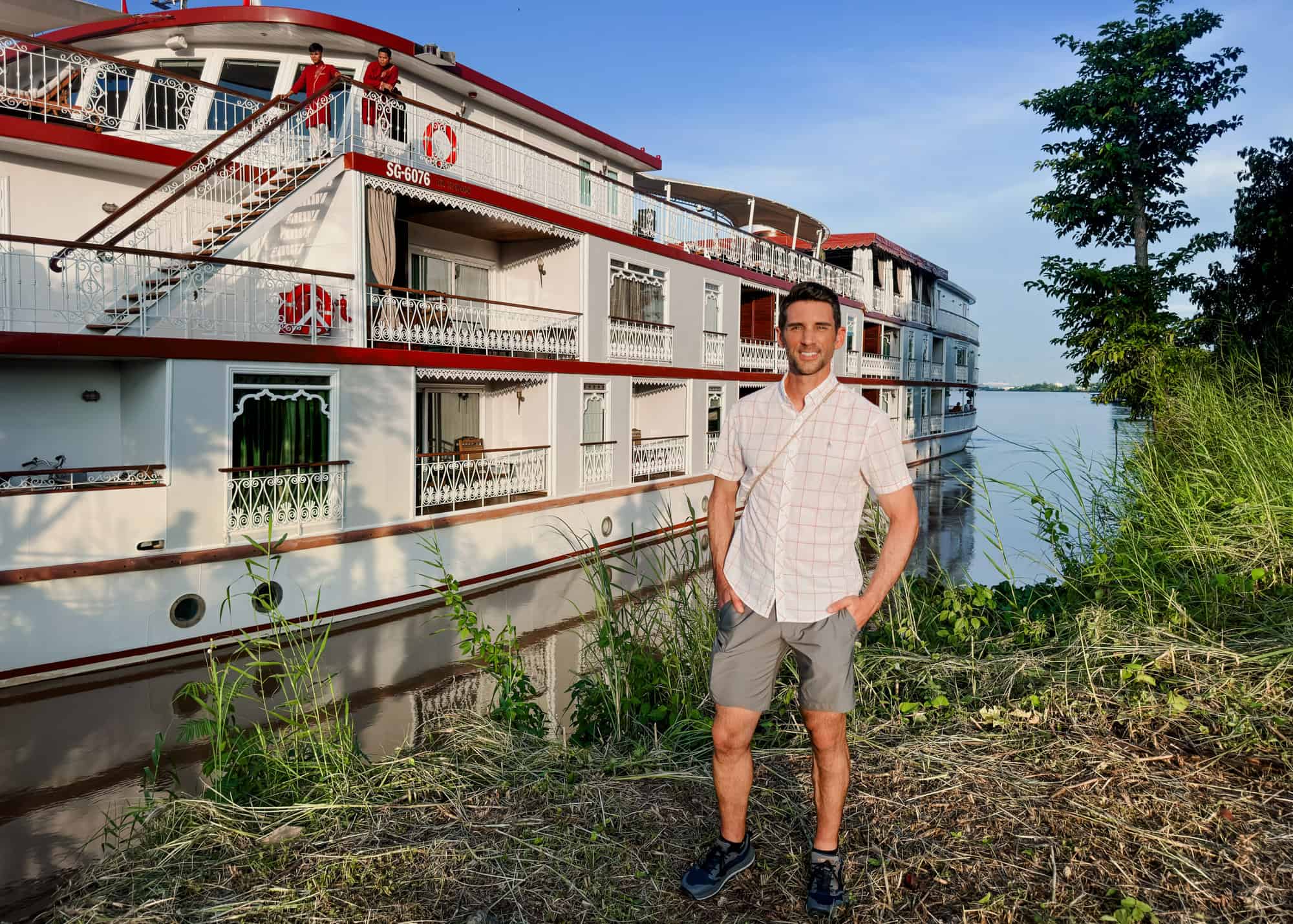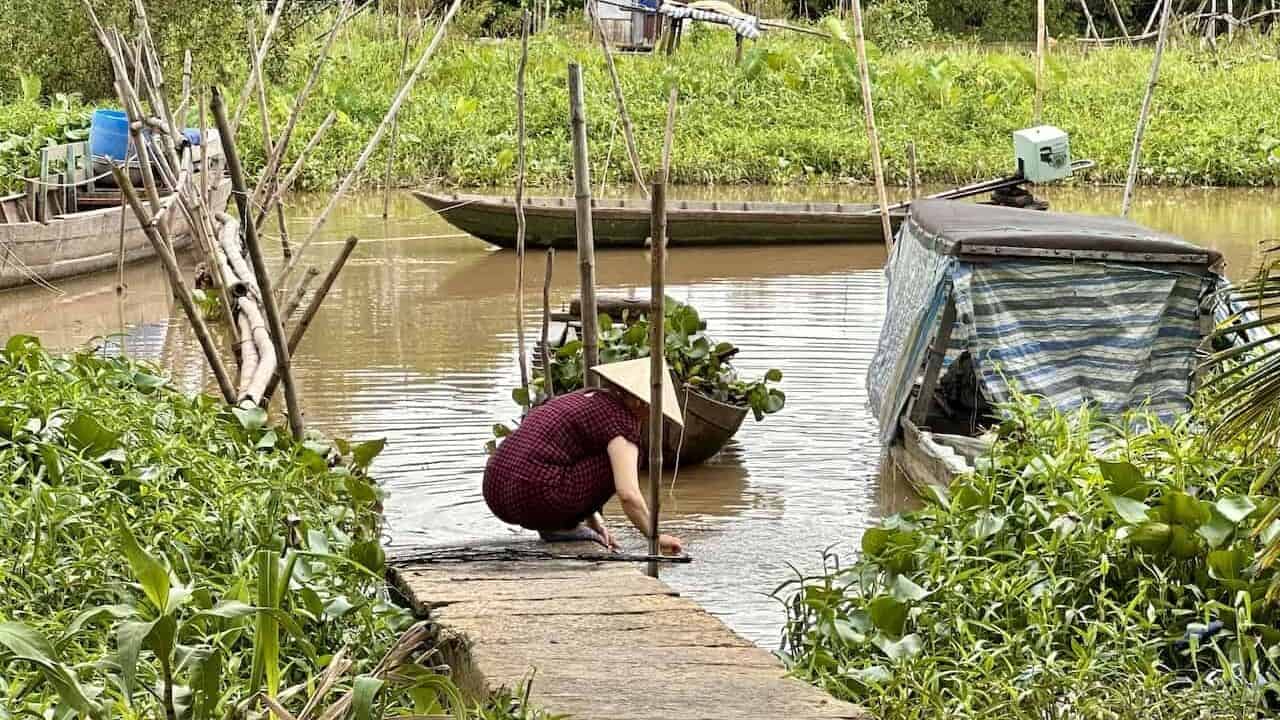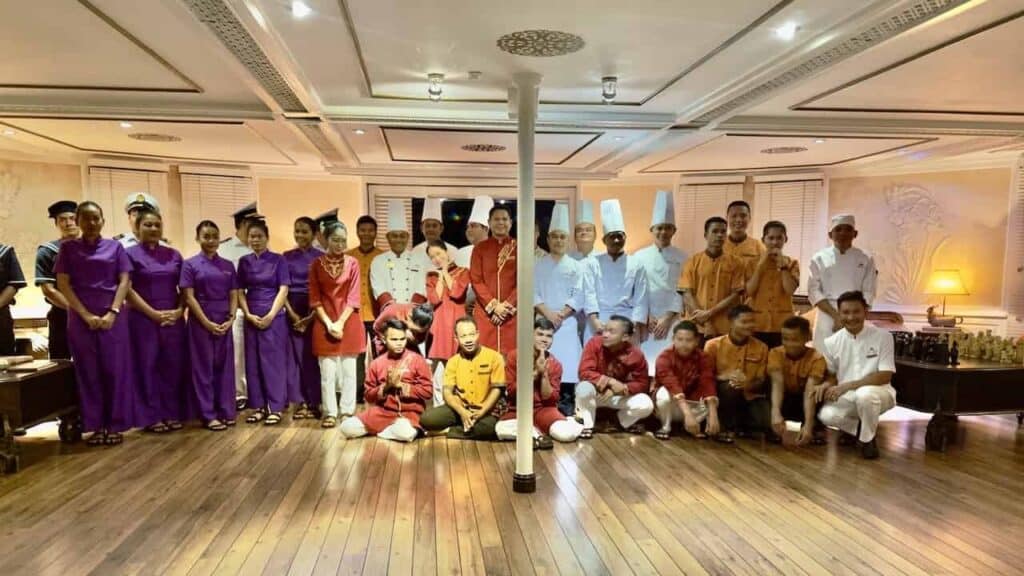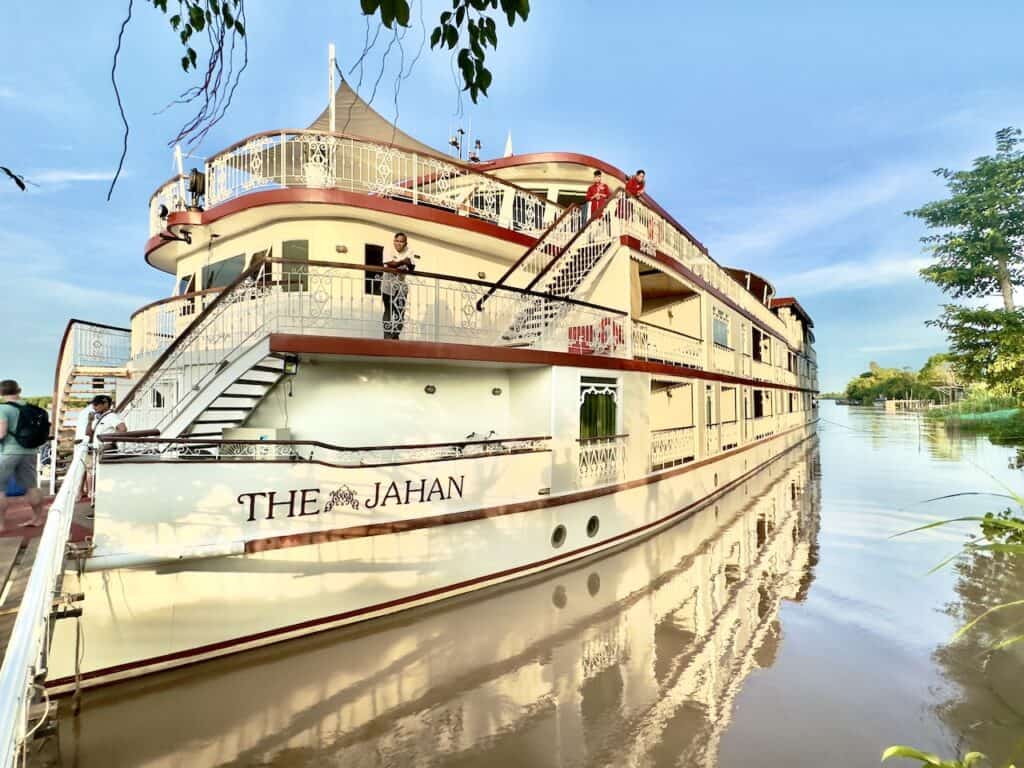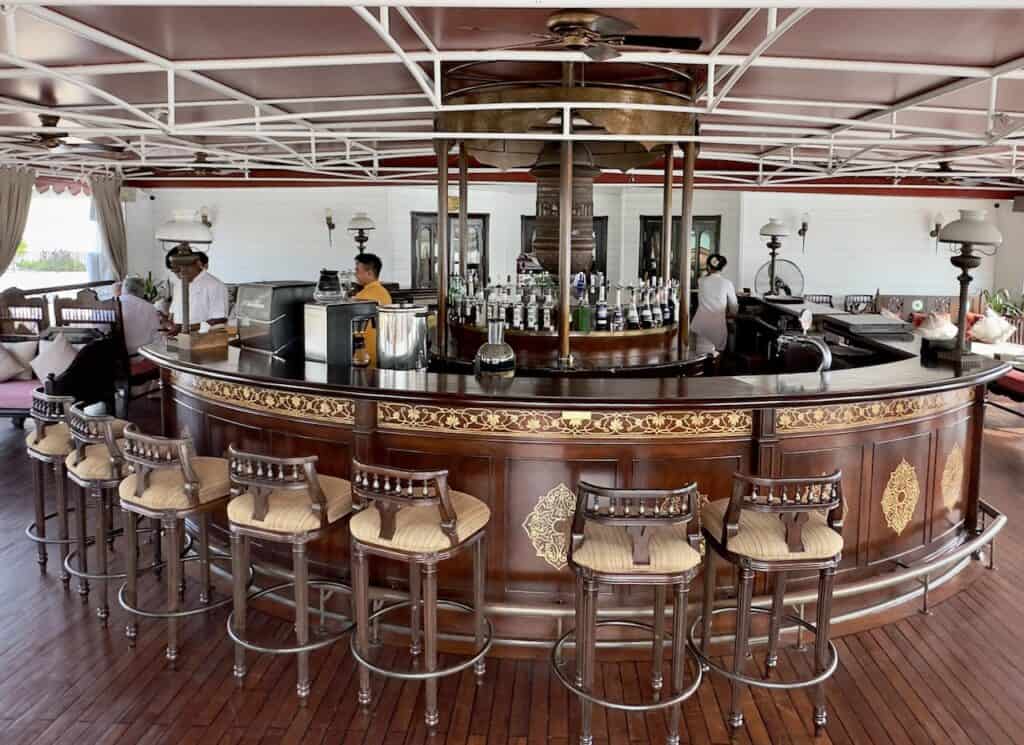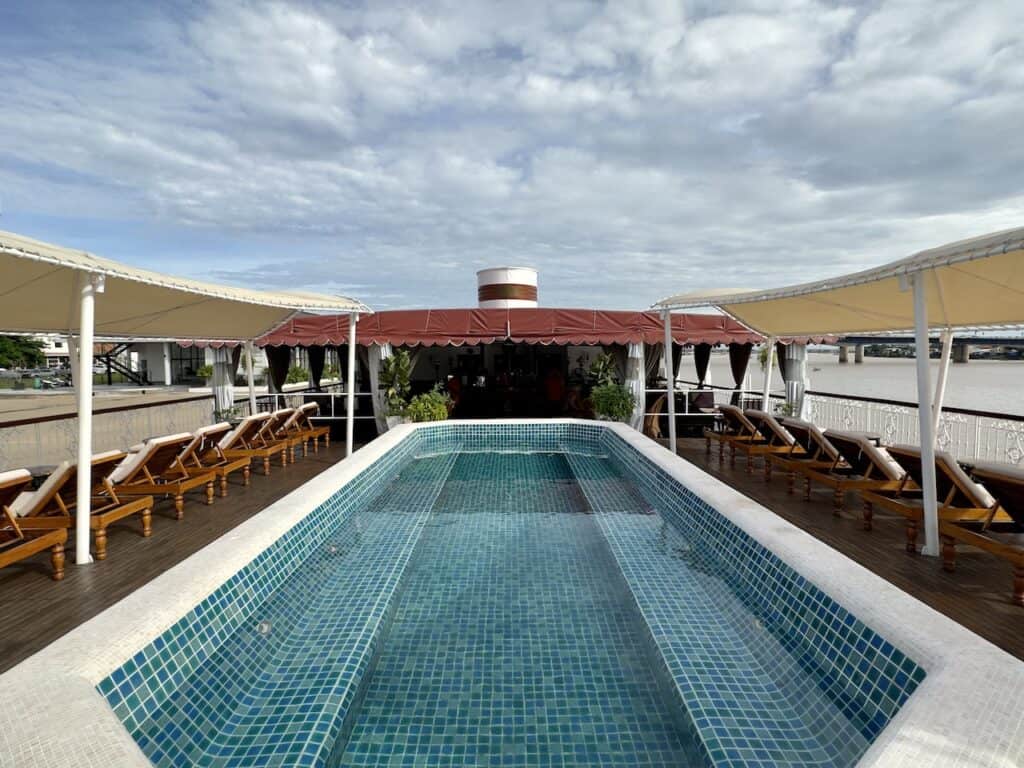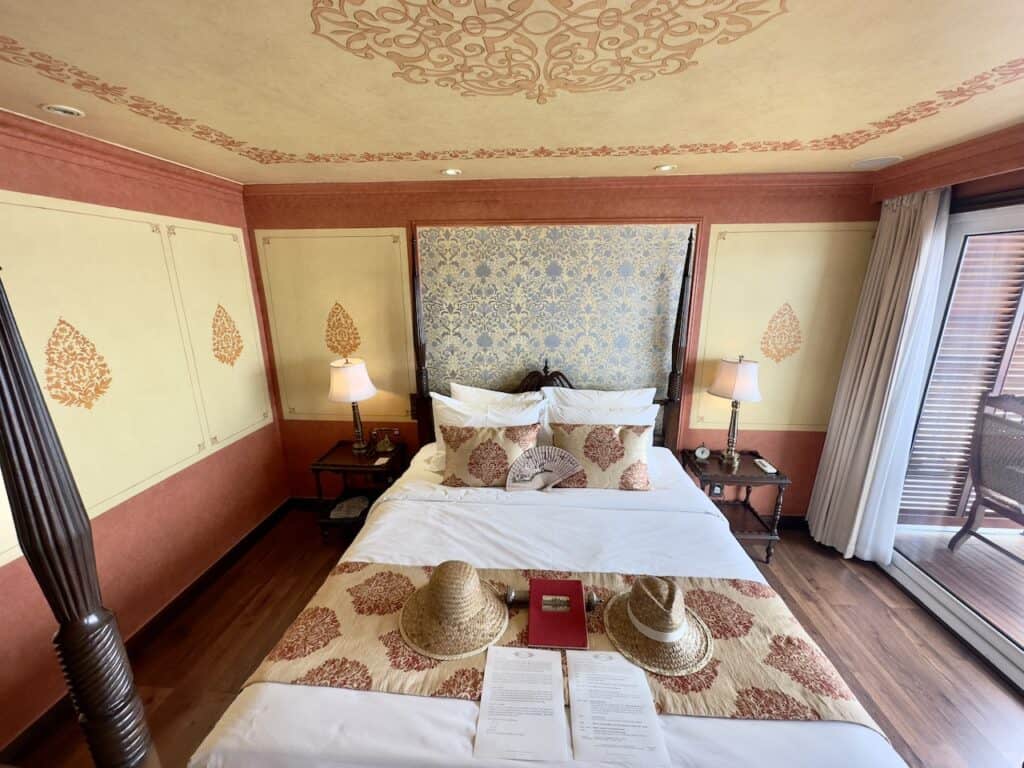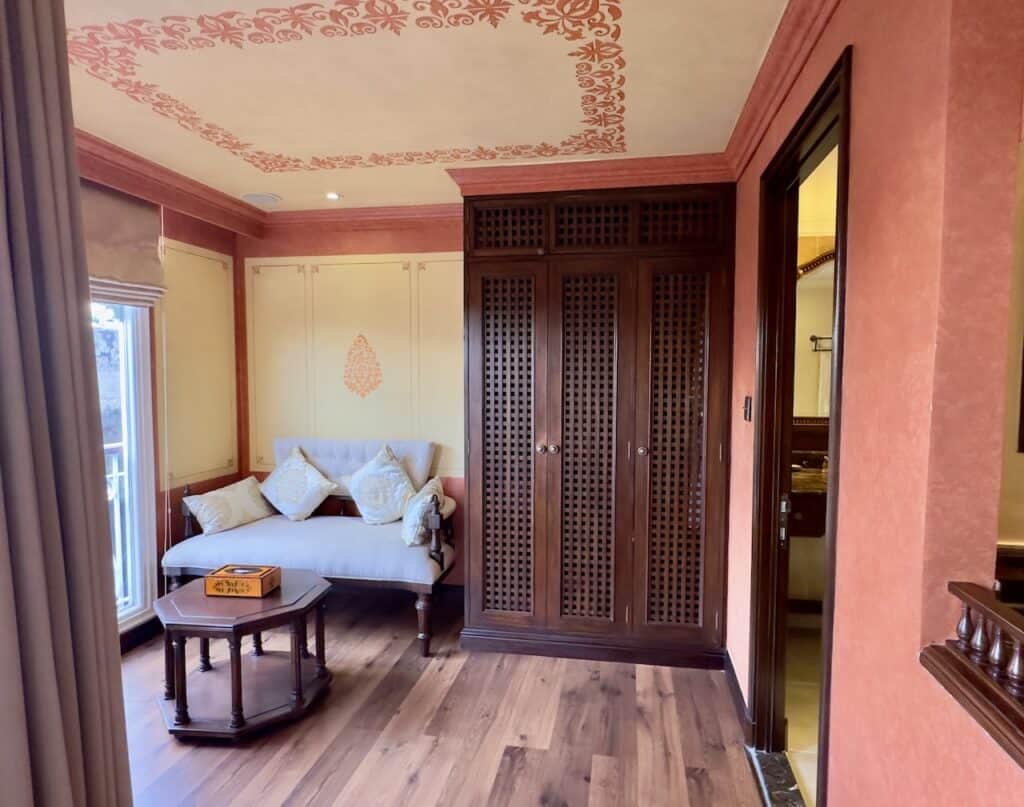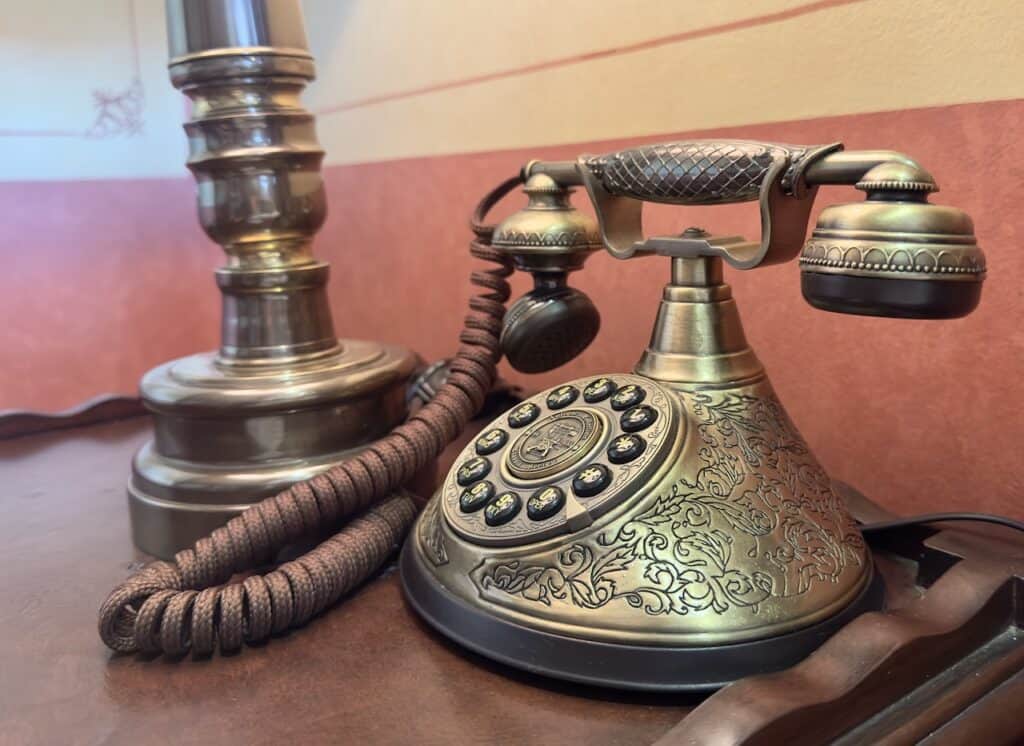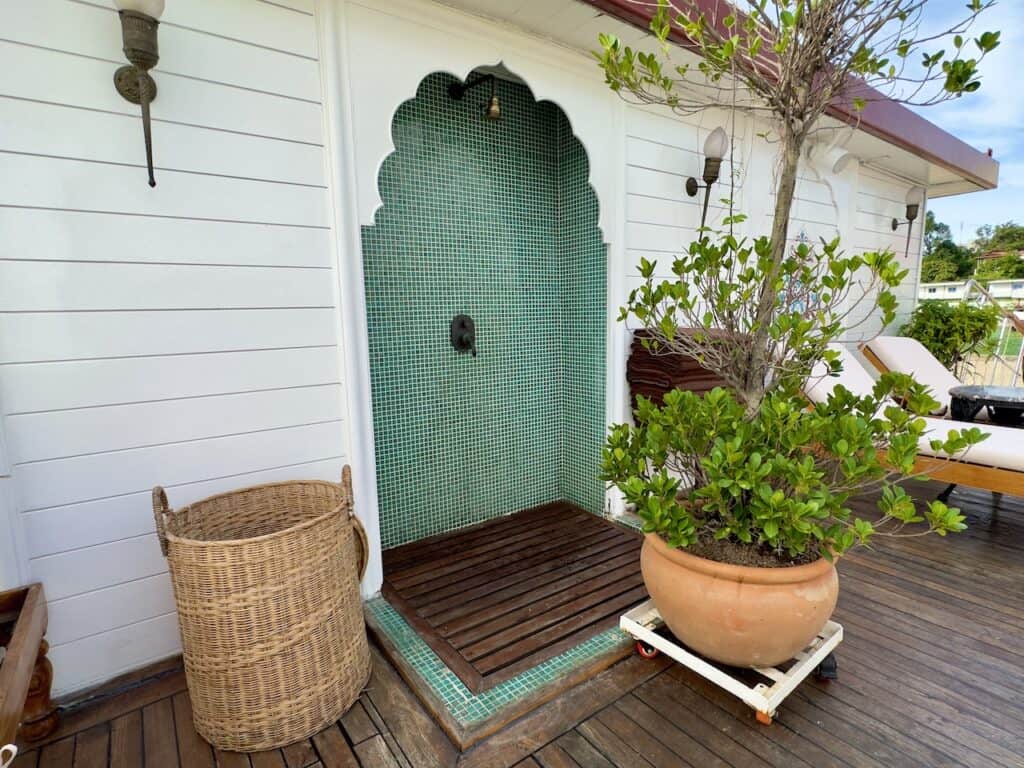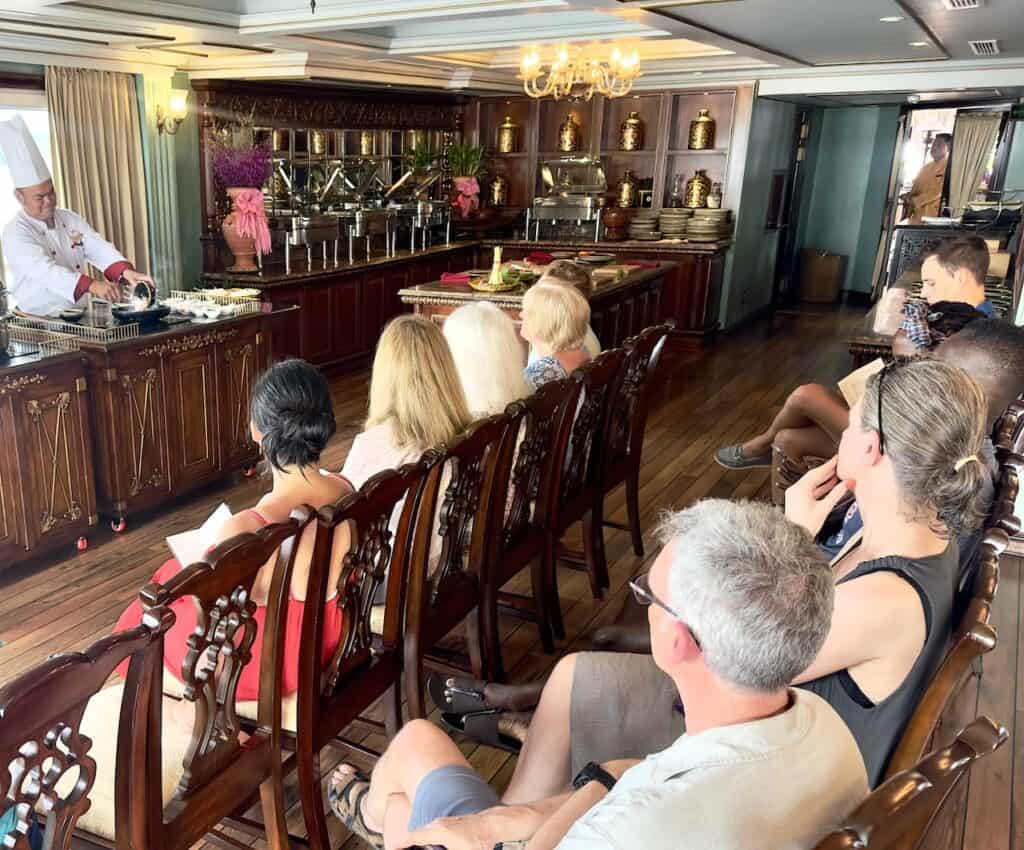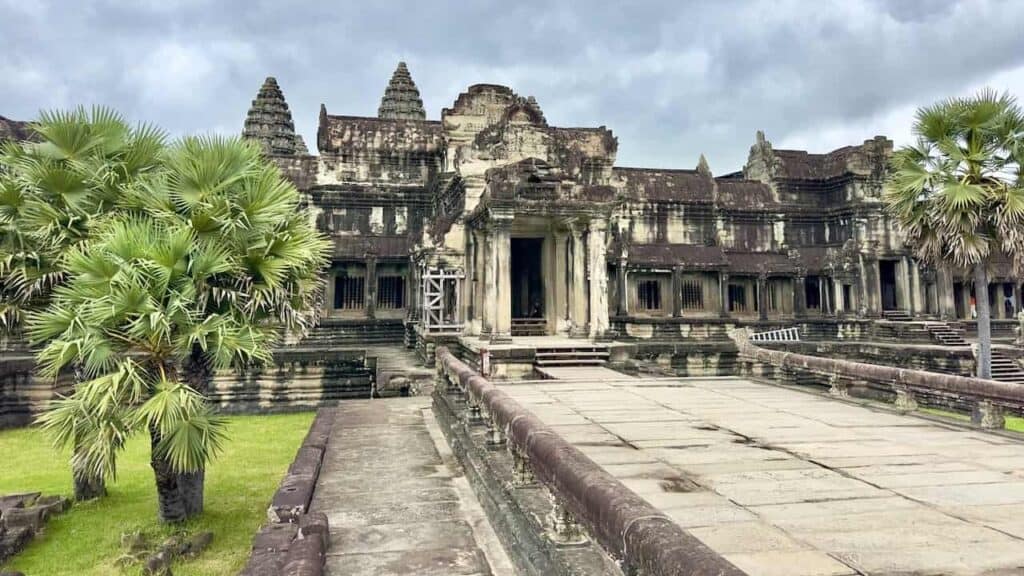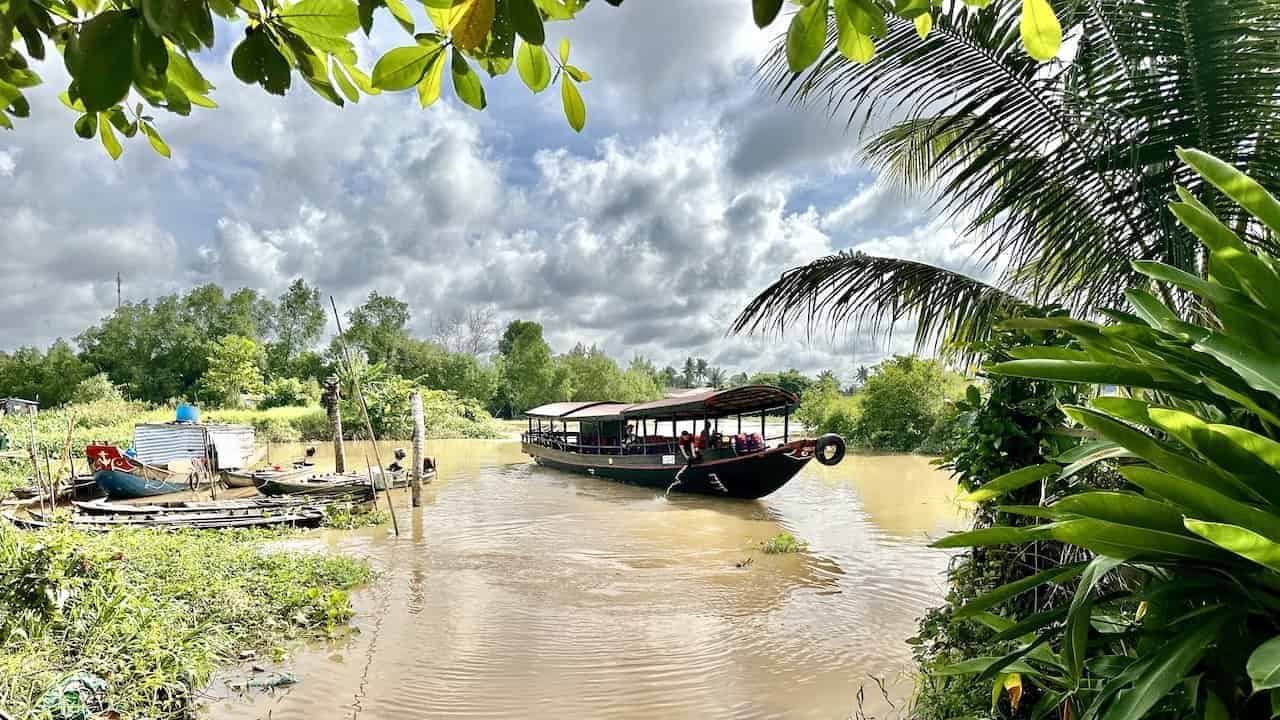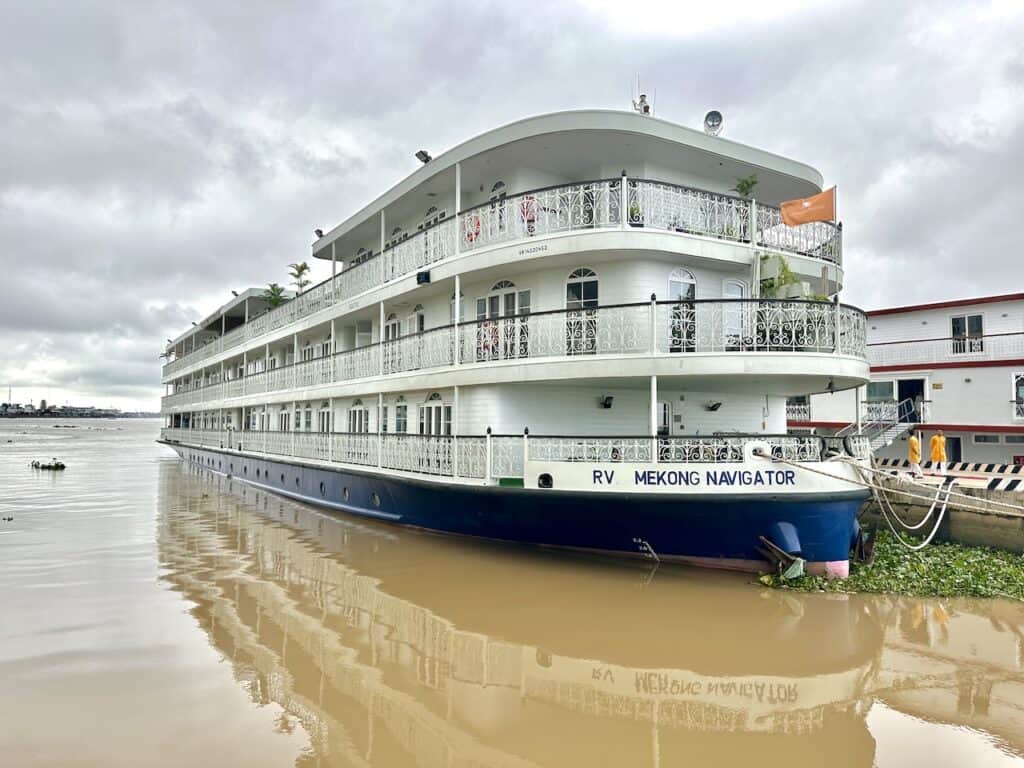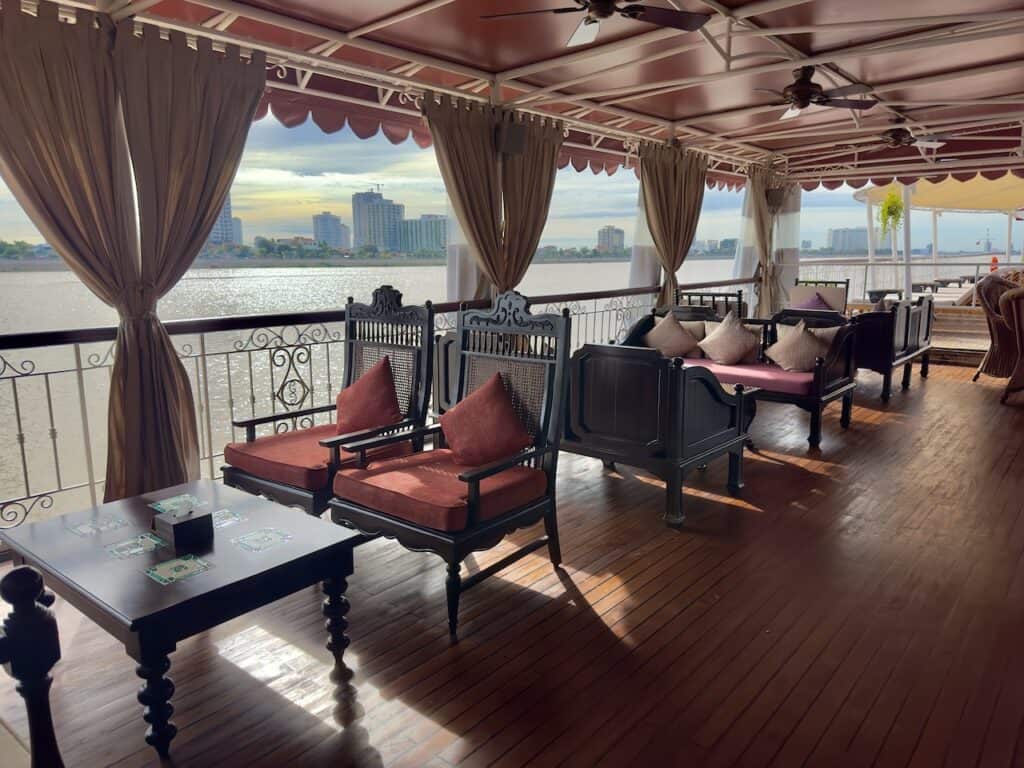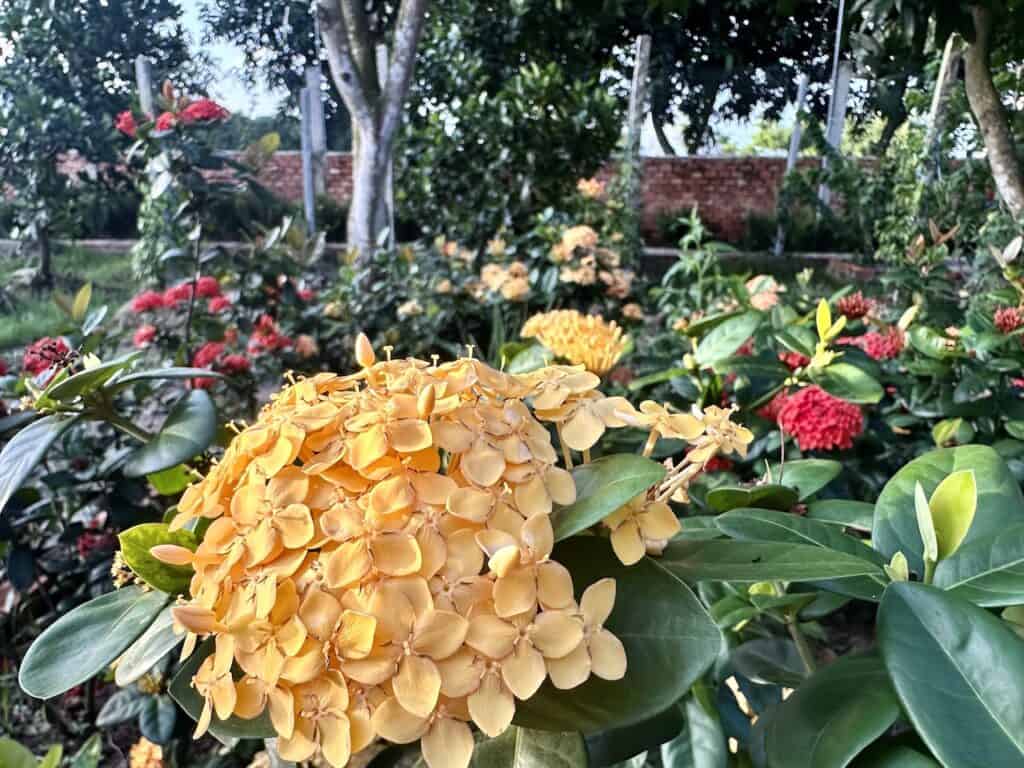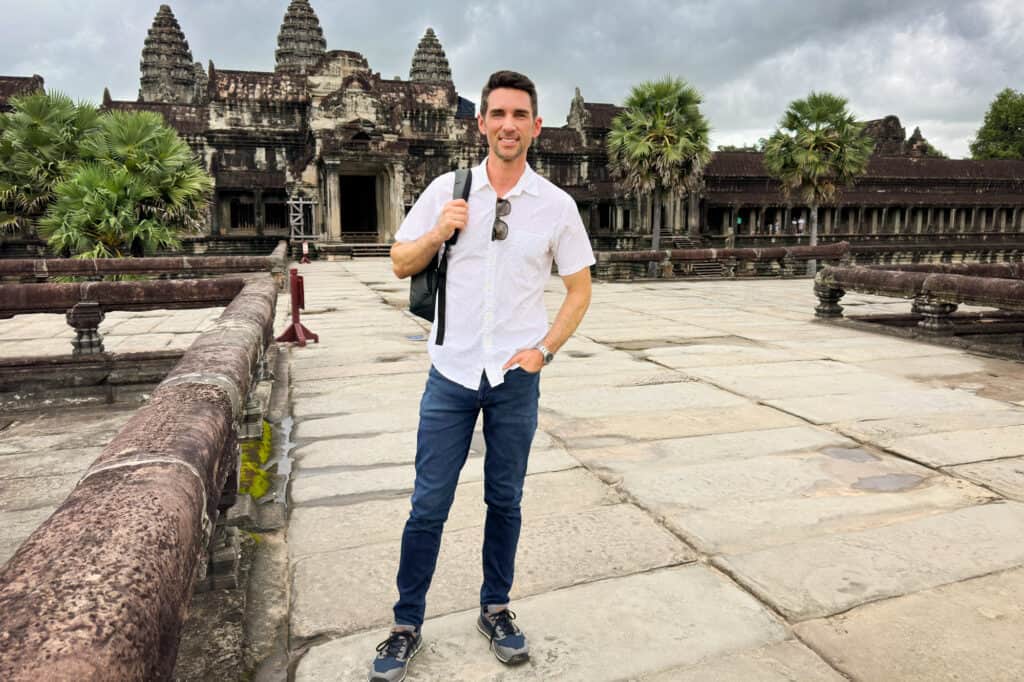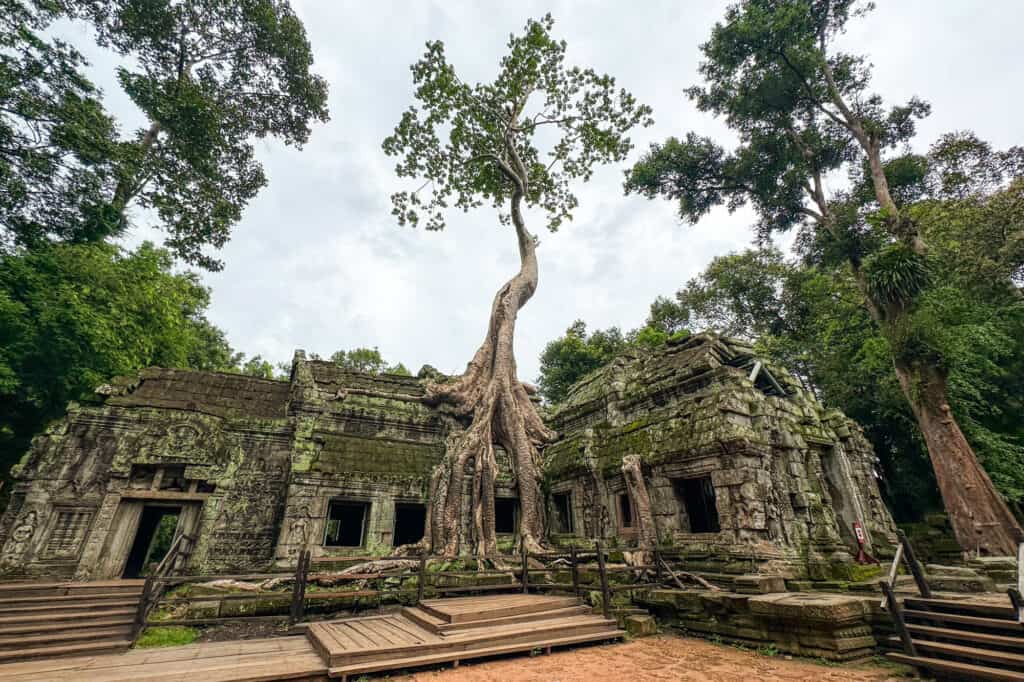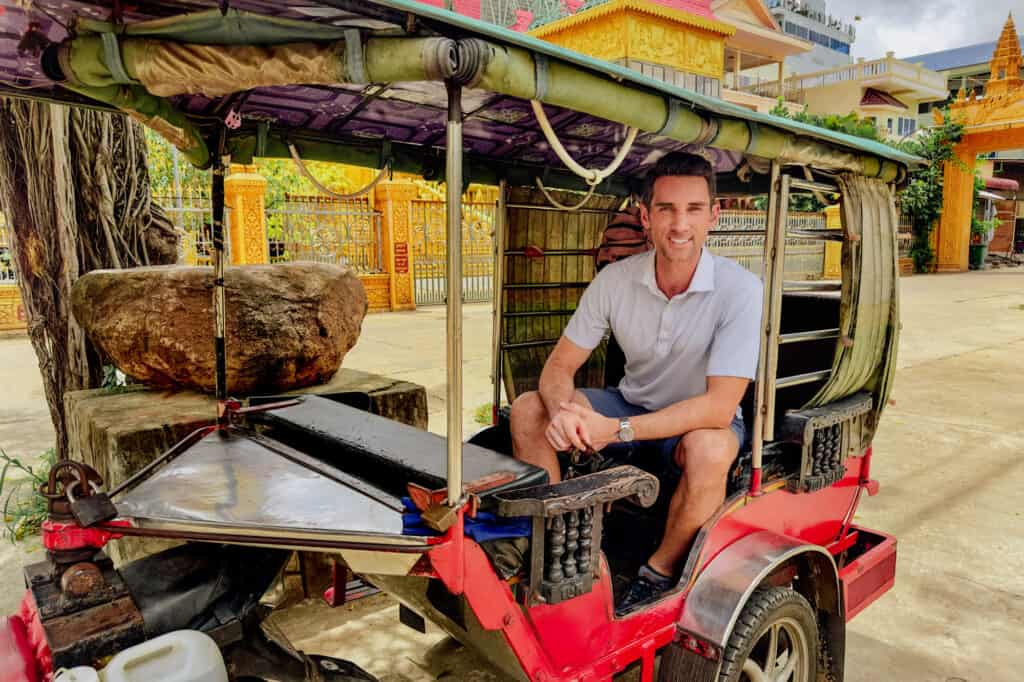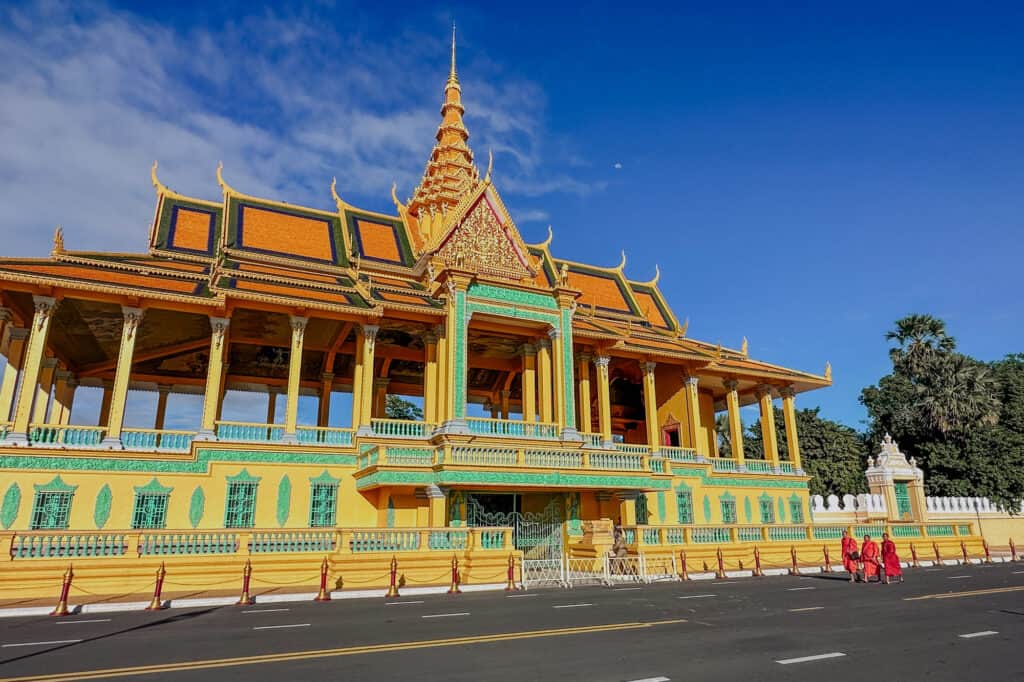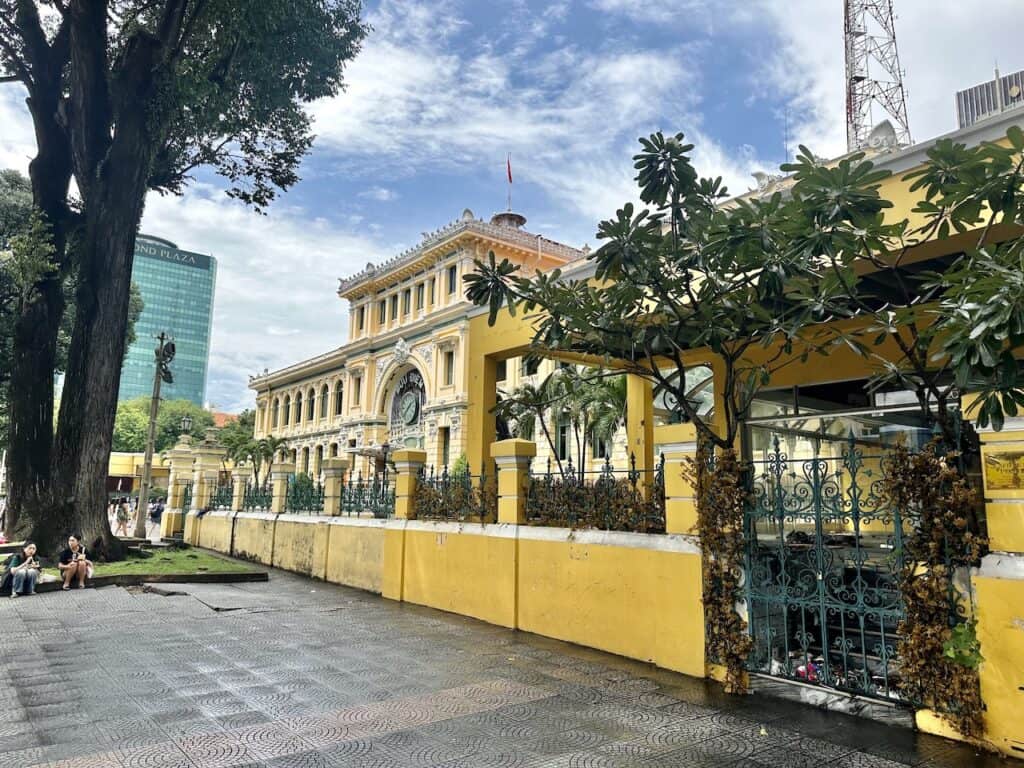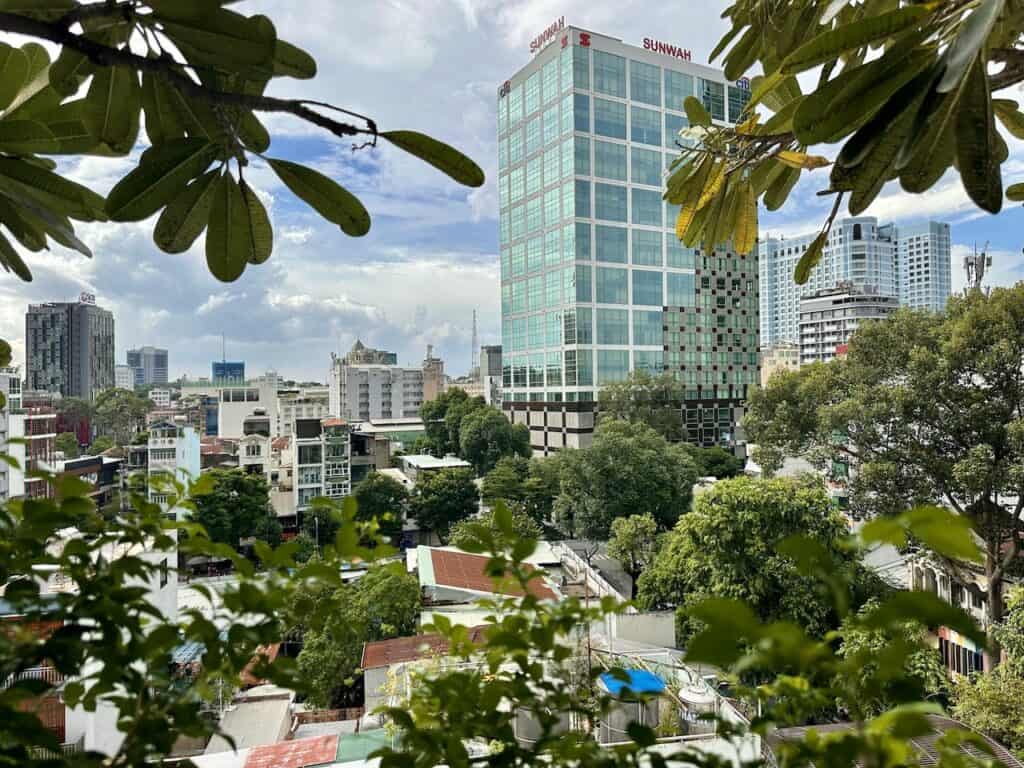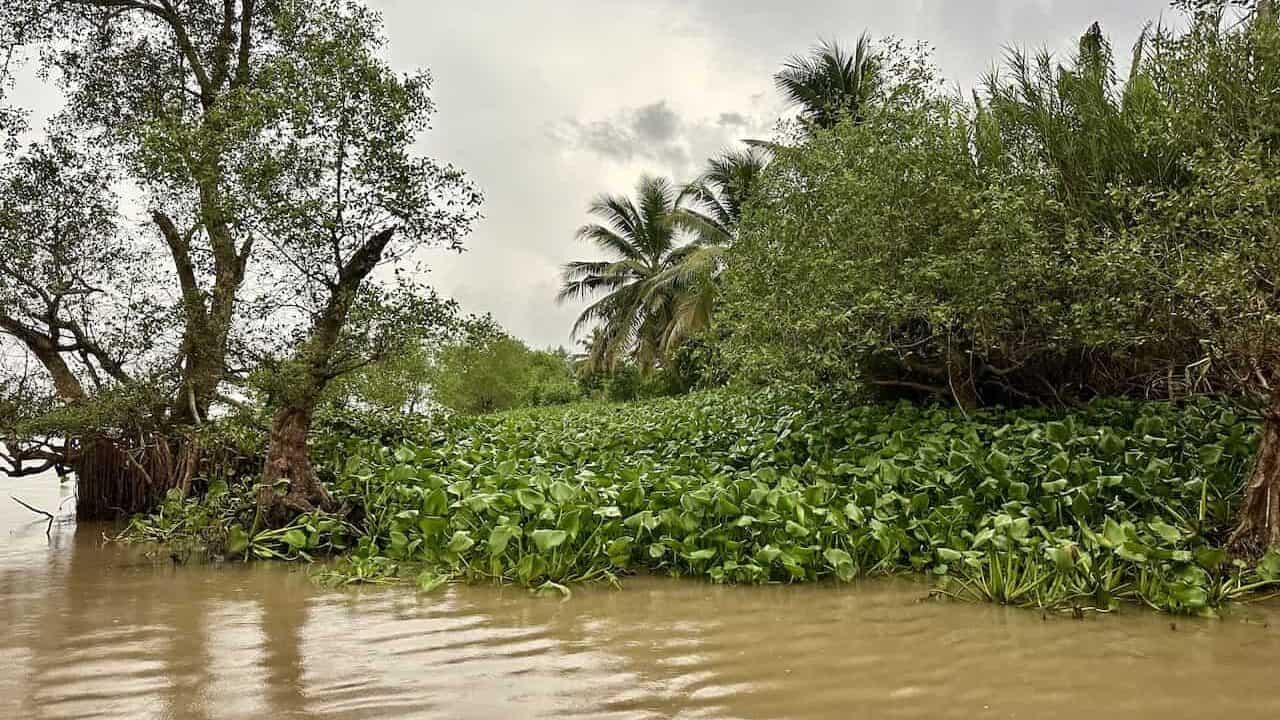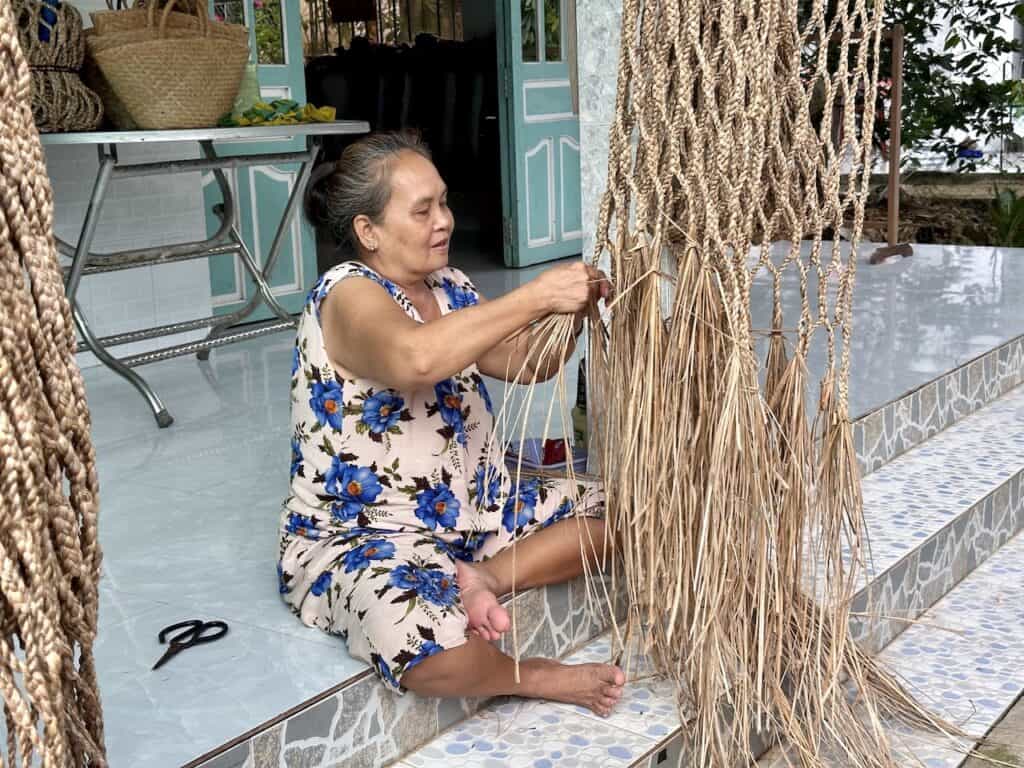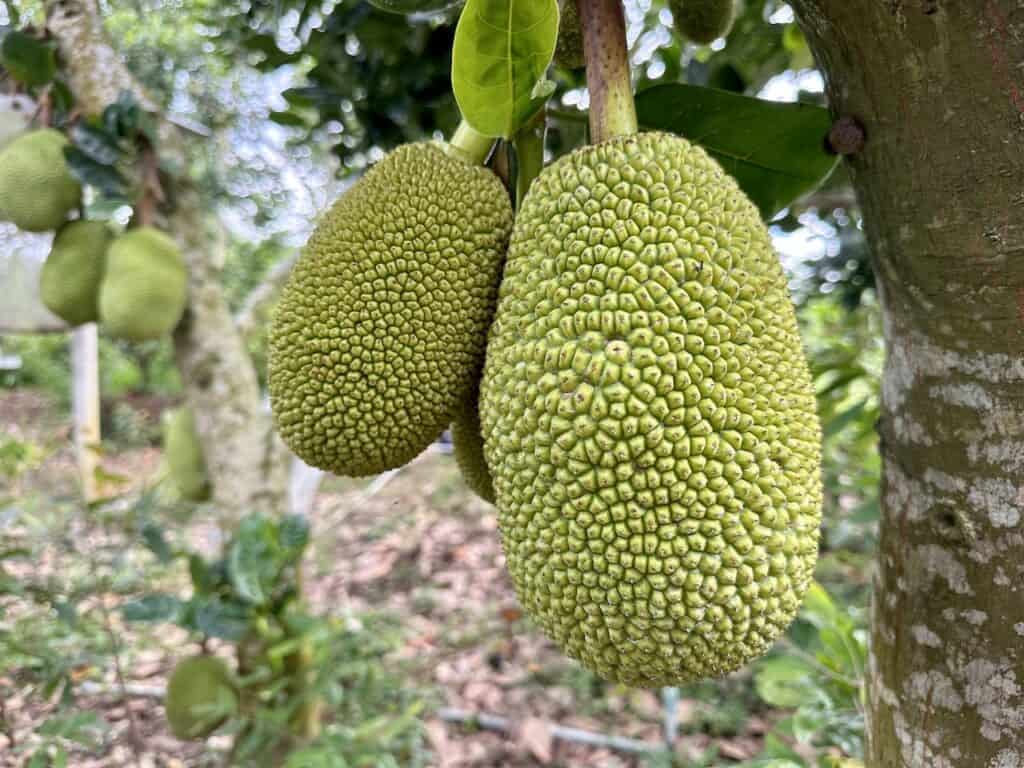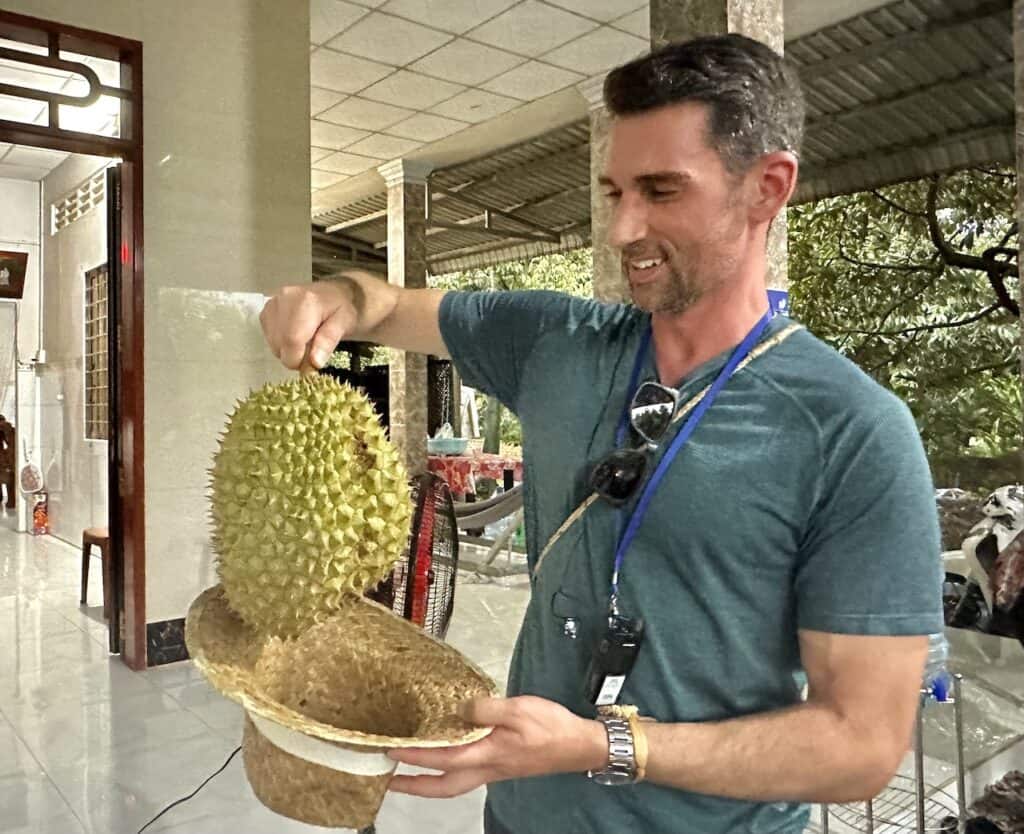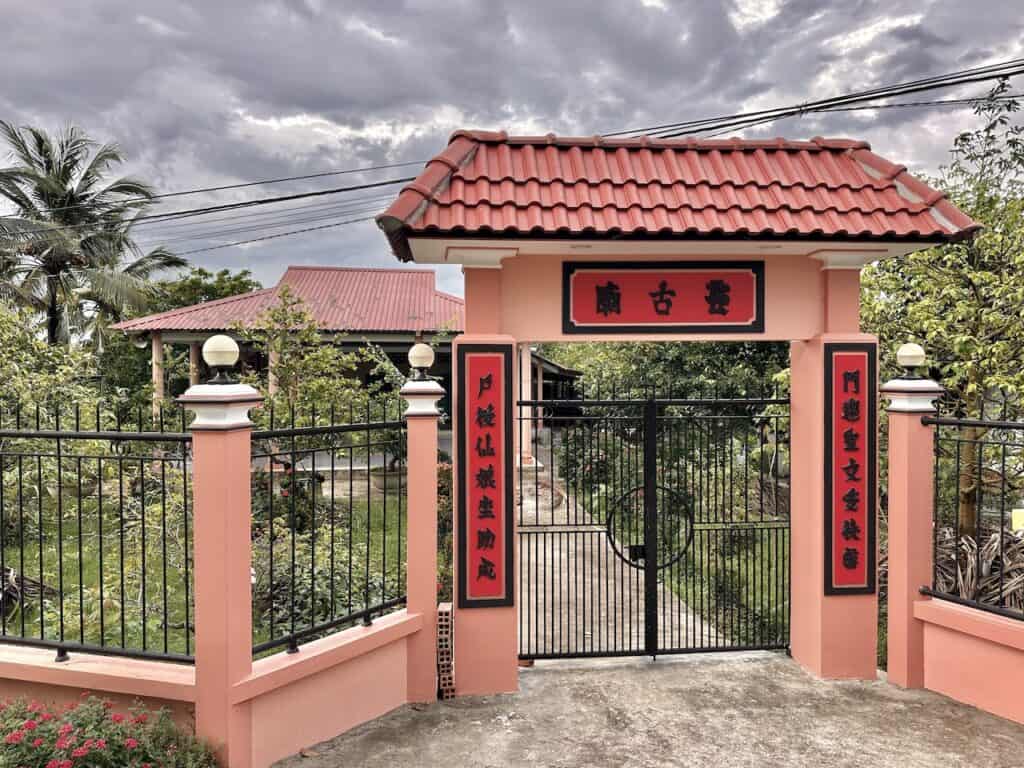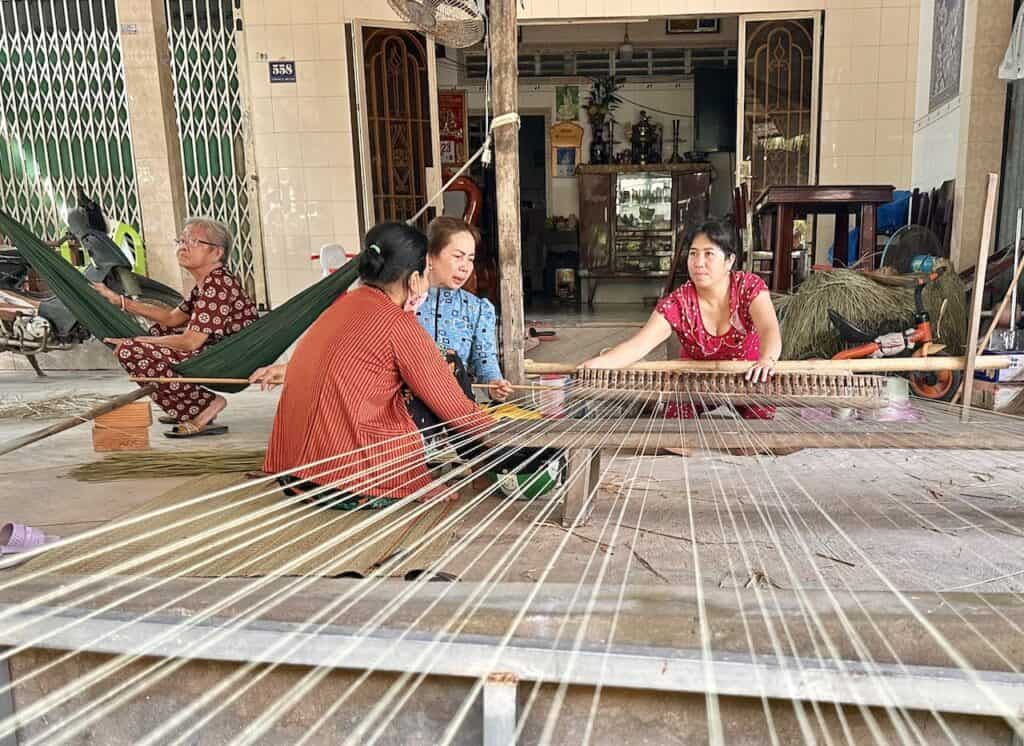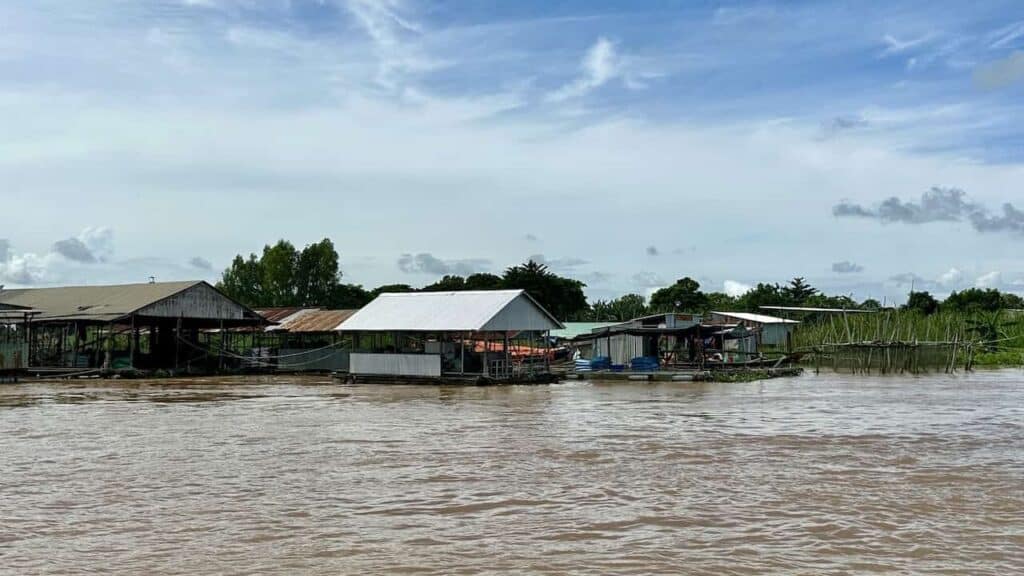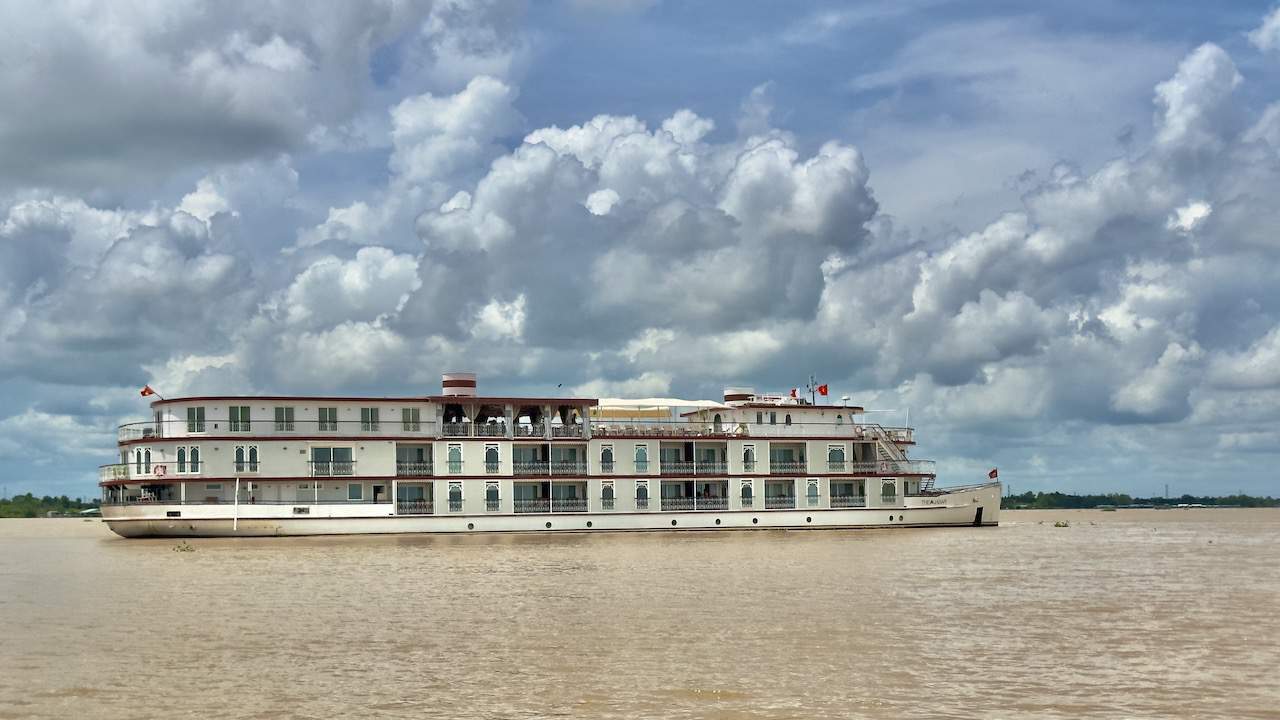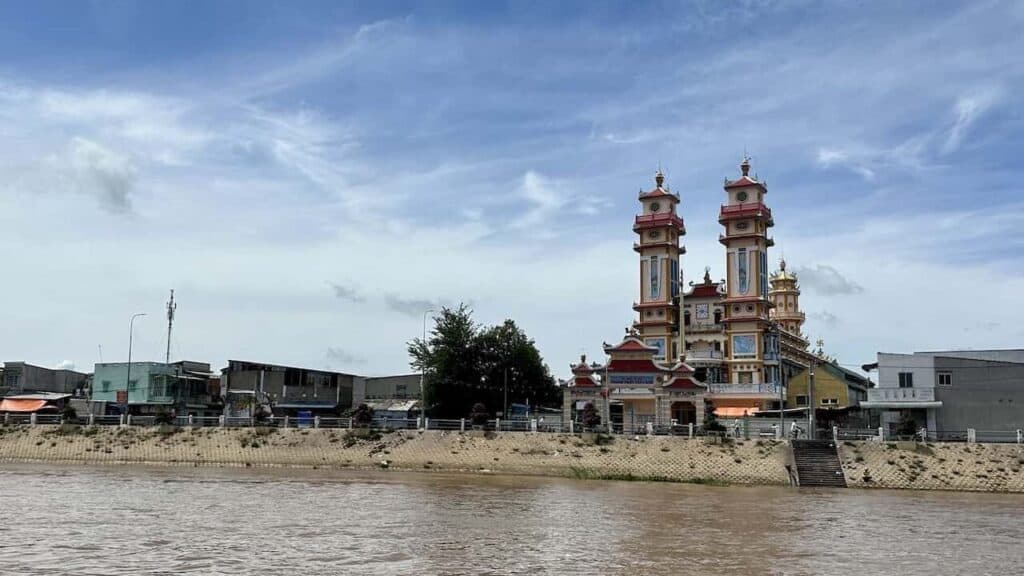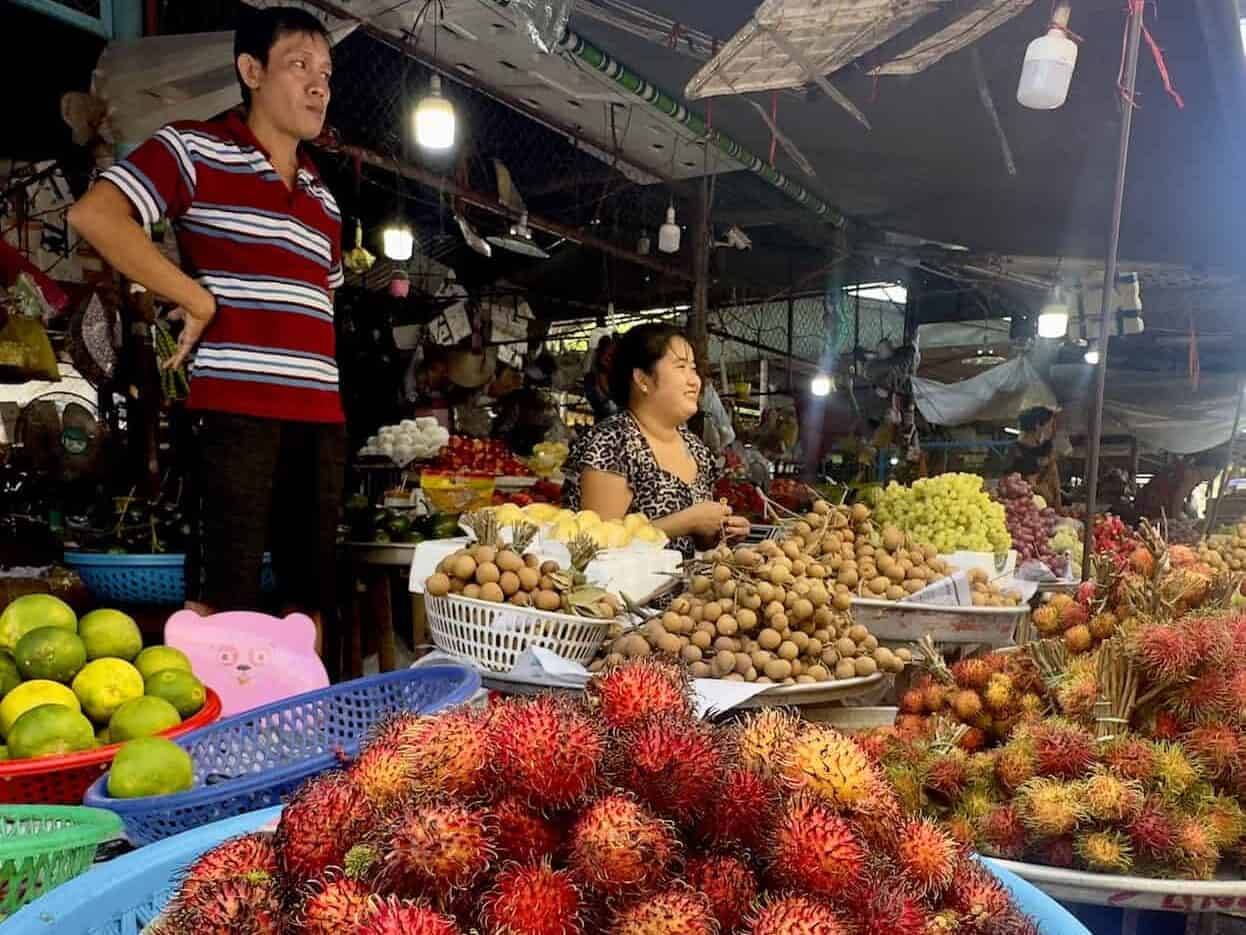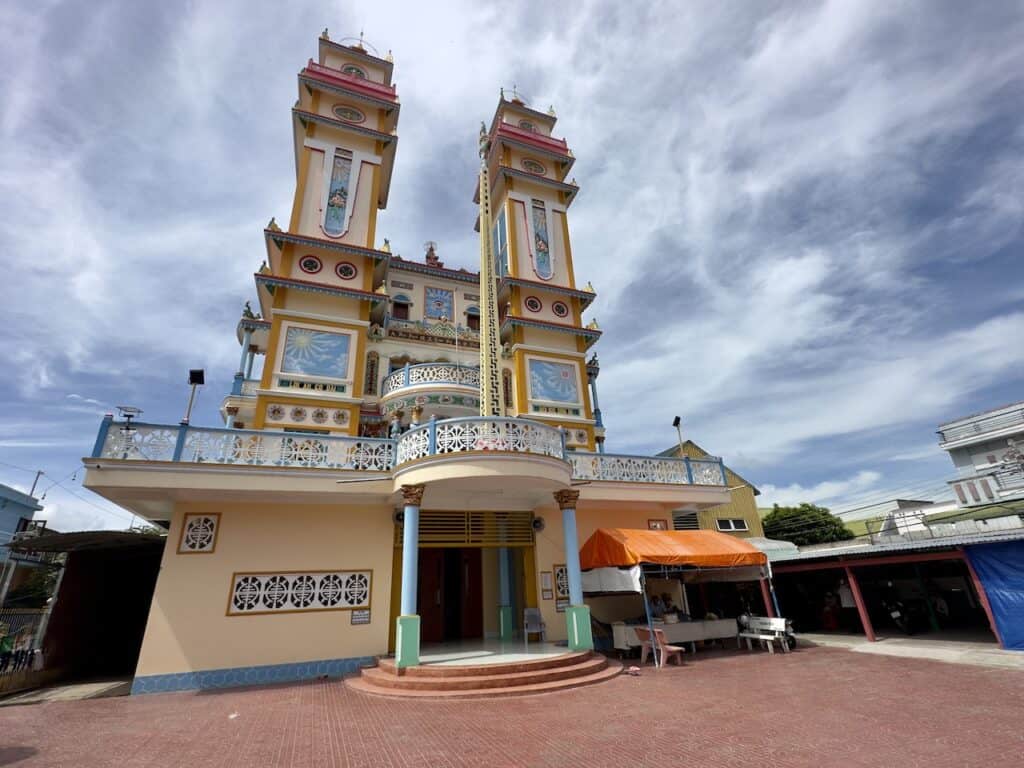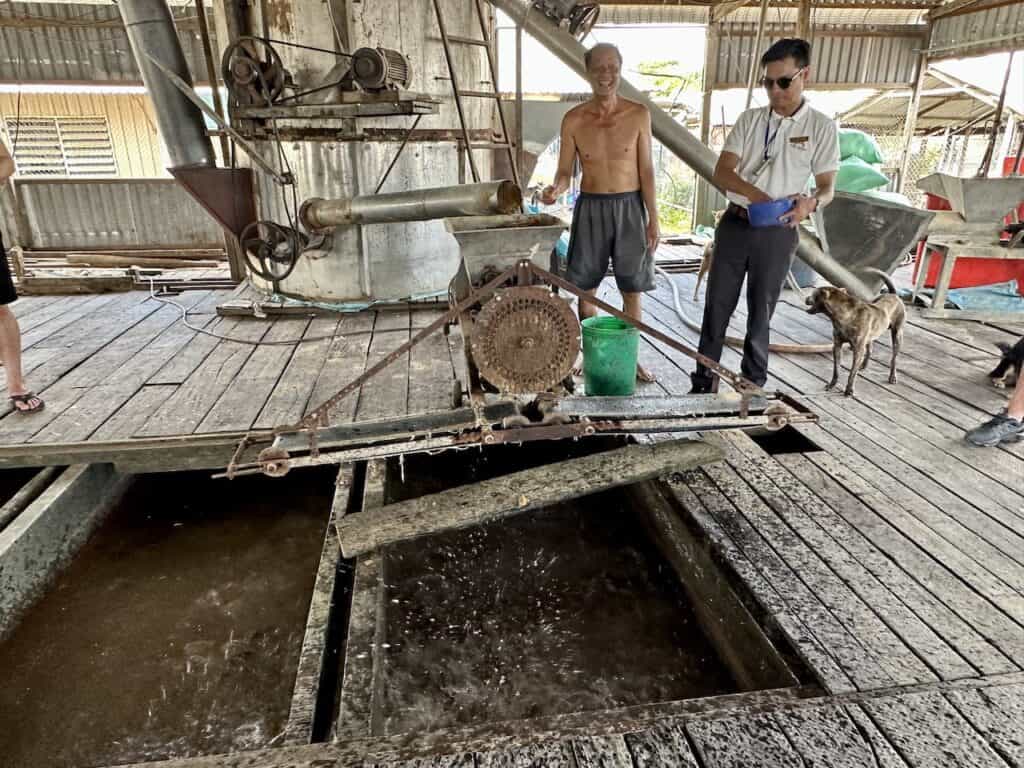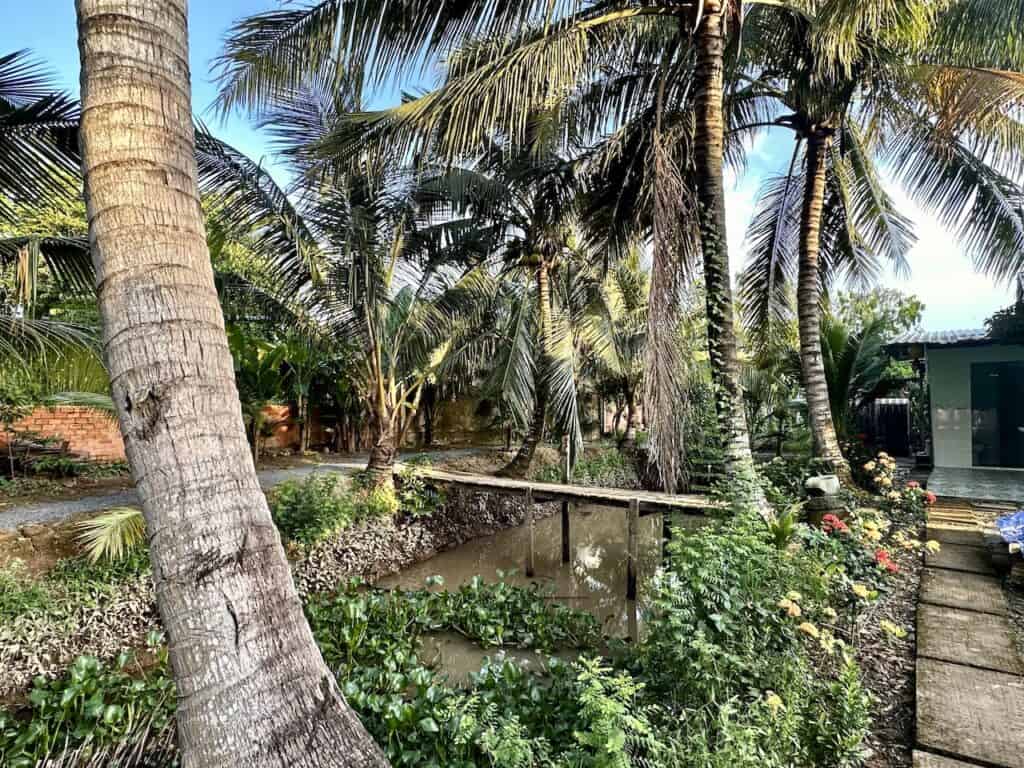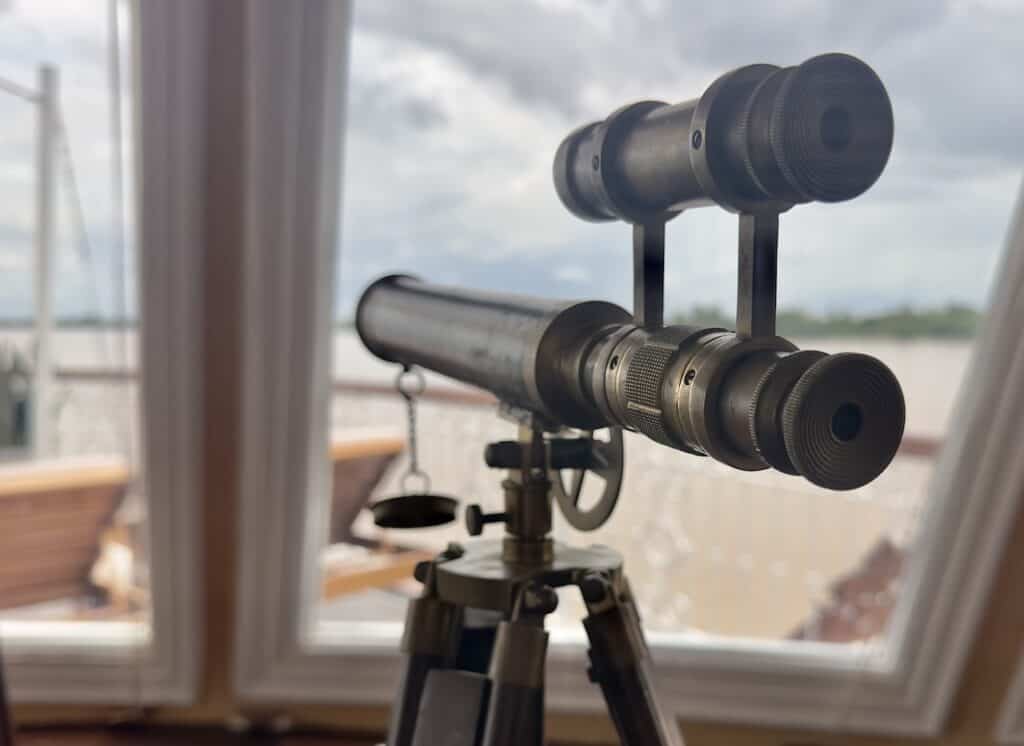What to Expect on a Mekong River Cruise: Cambodia & Vietnam
Taking a Mekong River cruise is an immersive cultural experience, which will take you through parts of Cambodia and Vietnam, depending on what kind of tour or cruise you book.
It’s also an efficient way to visit many different cities, villages, and islands in just a few days, and learn about their customs, economies, culture, and cuisine!
You can cruise the Upper Mekong (through Laos), but I’m going to focus more on the Lower Mekong Delta, through Cambodia and Vietnam.
Mekong River Cruise Tours
There are a wide variety of Mekong Rivery cruise options. I’ll focus mostly on the luxury Heritage Line Cruises in sections down below.
These other 1, 2, and 3-day options also come highly rated:
➡️ Click to Book: 3 Days on the Mekong Delta
- From Ho Chi Minh City
- Visit villages and markets along the Mekong
- Overnights in hotels
➡️ Click to Book: 2 Days on the Mekong
- From Ho Chi Minh City
- Visit pagodas, villages, and markets on the Mekong
- Overnight in a hotel
➡️ Click to Book: Private Mekong Tour
- Private 3-day tour for just your group
- From Ho Chi Minh City
➡️ Click to Book: Private Day Tour
- From Ho Chi Minh City
- Private full-day tour for just your group on the Mekong
➡️ Click to Book: Cruise in Cambodia
- Day tour from Siem Reap, Cambodia
- Visit villages on Tonle Sap Lake
Heritage Line: Luxury Mekong River Cruises
Heritage Line is a luxury cruise company that operates in Southeast Asia, and is known for providing upscale cruise experiences in the Mekong Delta region.
Heritage Line’s Lower Mekong River cruises typically include visits to various villages and cities along the Mekong River in Vietnam and Cambodia. Passengers get to experience the culture and traditions of the region, visit local markets and villages, and enjoy onboard amenities and services that cater to a luxury travel experience.
The boats are beautiful, but it’s the staff onboard that makes a Heritage Line cruise so special. They’ve found the most friendly, knowledgeable crew to run the bridges, kitchens, lounges, and tours.
A staff of 42 operates the Jahan!
Heritage Line Ship: The Jahan
The Jahan is a beautiful river boat, which sails the Mekong River through both Cambodia and Vietnam. It launched in 2011.
It’s spacious, and the limited number of passengers will keep you from ever feeling crowded onboard. There are two lounges (one inside and one outside).
The Jahan also has a big sun deck with a pool, and an observatory on the top floor at the front of the ship.
The Heritage Line features 3, 4, or 7-night Mekong River cruises on the Jahan.
Visitors have 26 suites and staterooms to choose from. Each has its own private bathroom and private balcony.
The accommodations range from 325 square feet up to 550 square feet.
The Jahan is named after a 16th-century Indian emperor, and the ship draws its design inspiration from Indian culture.
The decor includes old-world throwbacks, from antique phones to skeleton keys for the doors.
There’s a spa onboard, offering massages, along with a small gym, and an outdoor shower on the upper deck.
The food is excellent and usually served buffet-style for breakfast and lunch. Two chefs are on hand at the meals to prepare dishes made-to-order (in addition to the buffet). Dinner is more of a fixed menu, with choices for each of the five courses.
The chefs do a nice job catering to specific dietary requirements, etc. They also host cooking classes, for anyone onboard who wants to learn more about local cuisine.
Prices for a cruise on the Jahan start at $1,100 for 3-nights during the rainy season. They range up to the $6,000-range for 7-night cruises in the winter months.
Heritage Line Ship: The Jayavarman
The Heritage Line’s other ship taking passengers on the Lower Mekong River is the Jayavarman. It’s named after a Cambodian monarch, known for building some of the famous and mysterious temples which draw so many tourists to the Angkor region.
The Jayavarman has 27 staterooms and suites on two decks, and is decorated in a French-Colonial motif. Each has a private bathroom and private balcony. The size of each ranges from 215 square feet to about 300 square feet.
The ship has lounges and a sun deck with a pool, in addition to the standard dining facilities.
Similar to the Heritage Line’s Jahan, the Jayavarman takes passengers on 3, 4, and 7-night cruises on the Mekong River through Vietnam and Cambodia.
Prices for a cruise on the Jayavarman range from about $1,100 for 3 nights in the summer months, to $4,700 for 7 nights in the suite during the winter months.
What to Expect on a Mekong River Cruise
Mekong River cruises offer an adventure through Cambodia and Vietnam. The natural beauty, cultural immersion, and relaxation make them a popular choice for travelers looking to explore this part of Southeast Asia.
Mekong River cruises offer a unique and immersive experience, with these main perks:
- Scenic Beauty: The Mekong River winds its way through lush, picturesque landscapes, including rice paddies, fruit orchards, and dense tropical forests.
- Cultural Immersion: Mekong River cruises provide opportunities to visit traditional villages, interact with local communities, and experience the rich and diverse cultures of the region. Passengers can witness daily life along the riverbanks and learn about the customs and traditions of the people who call the Mekong Delta home. Many will actually allow you into their homes!
- Unique Cuisine: The Mekong cruises serve a mix of authentic local cuisine, allowing passengers to savor the flavors of the Mekong Delta, which includes fresh seafood, tropical fruits, and regional specialties.
- Markets: The Mekong Delta’s villages are famous for their markets, and your river cruise is sure to stop at one or more.
- Relaxation: Mekong River cruises provide a tranquil and leisurely pace of travel. Passengers can relax on deck, enjoy the soothing rhythm of the river, and take in the serene surroundings.
- Historical and Educational Opportunities: The Mekong Delta has a rich history, and cruises often include stops at historical sites, pagodas, and museums.
Mekong River Cruise Prices
As you’d expect, prices for a Mekong River cruise vary. The prices will depend on:
- The time of year you travel.
- The number of nights you stay onboard.
- The kind of cabin or suite you book.
Cruise prices tend to be much lower from May through September (the hot, rainy season).
Here are a few examples, just to give a ballpark.
On the lower end, you can:
- Take a sunset cruise from Phnom Penh for under $75.
- Take a day cruise from Ho Chi Minh City for under $75.
On the higher end, you can:
- Take a 7-night luxury Mekong River cruise for $6,000.
- Take a 3-night luxury cruise for $2500.
The prices include meals and excursions to shore.
The Mekong River Delta
The Mekong River is one of the longest and most important rivers in Southeast Asia, flowing through multiple countries in the region. Here’s a brief synopsis of the Mekong River:
- Geography: The Mekong River is approximately 4,350 kilometers (2,703 miles) long. It originates in the Tibetan Plateau and flows down through China, Myanmar, Laos, Thailand, Cambodia, and Vietnam before emptying into the South China Sea.
- Cultural and Ecological Significance: The Mekong River plays a vital role in the livelihoods of millions of people. The river supports various economic activities, including agriculture, fishing, transportation, and trade.
- Challenges: The Mekong River faces various challenges, including dam construction, deforestation, pollution, and climate change. In Vietnam, you’ll hear complaints that Chinese dams are taking too much of the water, and keeping water levels too low on the Lower Mekong.
Stops on a Mekong River Cruise
A Mekong River cruise typically covers several cities and towns in different countries as it navigates through the Mekong Delta region in Southeast Asia. The specific cities and towns that a Mekong River cruise may stop in can vary depending on the cruise itinerary and the cruise operator.
Here are some of the major cities and towns that are commonly included in Mekong River cruise itineraries:
- Ho Chi Minh City, Vietnam: Many Mekong River cruises start or end in Ho Chi Minh City, also known as Saigon, which is the largest city in Vietnam. Passengers have the opportunity to explore the city’s attractions before or after the cruise.
- My Tho, Vietnam: Located in the Mekong Delta region, My Tho is a common starting point for Mekong River cruises in Vietnam. It’s known for its scenic canals and floating markets.
- Cai Be, Vietnam: Cai Be is another Vietnamese town known for its floating market, which is a popular stop for Mekong River cruises. It’s fallen off the itinerary for some cruise lines, as some say the market is more for show than for playing a true role in the local economy.
- Phnom Penh, Cambodia: The capital city of Cambodia, Phnom Penh, is often included in the Mekong River cruise itineraries. Passengers can explore its rich history, including the Royal Palace and Killing Fields.
- Kampong Cham, Cambodia: Located in eastern Cambodia, Kampong Cham is known for its French colonial architecture and serene riverside setting.
- Kampong Chhnang, Cambodia: This town is famous for its pottery production and traditional stilt houses along the riverbanks.
- Siem Reap, Cambodia: Although not directly on the Mekong River, some cruises include a side trip to Siem Reap, where tourists visit the stunning Angkor Wat temple complex. Some tour companies offer transportation (around 4 hours) from the boat to Siem Reap. Others, like the Heritage Line, have an office in Siem Reap. This allows passengers to fly to the city, spend as much time as they’d like in the area, and then begin their Mekong River cruise.
- Tonle Sap Lake, Cambodia: Some Mekong River cruises include a visit to Tonle Sap Lake, Southeast Asia’s largest freshwater lake, known for its floating villages.
- Sa Dec, Vietnam: Sa Dec is a town known for its flower gardens and was the setting for parts of the novel “The Lover” by Marguerite Duras.
The Basics on Siem Reap
Siem Reap isn’t on the Mekong River, but it’s often “a stop” on a Mekong River Cruise or tour. Passengers are usually bused about 4-5 hours between the Siem Reap area and the dock on the river.
Beginning your river cruise by flying into Siem Reap allows you to explore Cambodia’s most popular region for international tourists. Angkor Wat is the most famous temple complex, but you’ll find many others nearby.
It’s worth arriving a few days early to see the sites around Siem Reap, before beginning your river cruise. Alternatively, if your river cruise ends in Siem Reap, it’s worth spending another night or two in a hotel in this part of Cambodia!
Among the sites to see:
- Angkor Wat: Siem Reap is famous for being the gateway to the Angkor Archaeological Park, which includes the iconic Angkor Wat temple complex. Angkor Wat is one of the most renowned archaeological sites in Southeast Asia and a UNESCO World Heritage Site.
- Angkor Thom: Within the Angkor Archaeological Park, Angkor Thom is another significant complex. It features the Bayon Temple with its famous smiling faces.
- Ta Prohm Temple: Known for its “Tomb Raider” fame, Ta Prohm is a temple that has been left in a semi-ruined state with trees and roots growing through its stone structures. (photo below)
- Tonle Sap Lake: While in Siem Reap, some cruise itineraries may include a visit to Tonle Sap Lake, the largest freshwater lake in Southeast Asia.
- Local Markets: Siem Reap has vibrant markets, including the Old Market (Phsar Chas) and the Angkor Night Market, where you can shop for souvenirs, handicrafts, clothing, and local products.
The Basics on Phnom Penh
A stop in Phnom Penh, the capital city of Cambodia, during a Mekong River cruise offers travelers a chance to explore a mix of history, culture, and modern life.
PRO TIP: Taking a tuk-tuk is easy and price-effective. A ride from the cruise ship dock to any of these sites will only be a few dollars. And remember: US Dollars are accepted everywhere in Cambodia!
Here are a few suggestions if you have a few hours to explore.
- Royal Palace: Visit the Royal Palace complex, which includes the Silver Pagoda, a stunning temple, and much more. (photo below)
- National Museum: The National Museum of Cambodia houses a vast collection of Khmer art and artifacts, providing insight into the country’s rich cultural heritage. It’s a great place to learn about Cambodia’s history and artistry.
- Tuol Sleng Genocide Museum (S-21): A somber but essential historical site, this former Khmer Rouge prison tells the tragic story of the Cambodian genocide. It serves as a sobering reminder of Cambodia’s recent history.
- Killing Fields (Choeung Ek): Located on the outskirts of Phnom Penh, the Killing Fields are another sobering historical site where you can learn about the atrocities of the Khmer Rouge regime. The site includes a memorial stupa filled with the skulls of victims.
- Wat Phnom: This is the city’s namesake temple and a tranquil place to visit. It’s located on a small hill in the city center and offers a peaceful escape from the bustling streets below.
- Central Market (Phsar Thmei): Explore this bustling market with its distinctive Art Deco architecture. It’s a great place to shop for souvenirs, clothing, jewelry, and local products.
The Basics on Saigon / Ho Chi Minh City
Most Mekong River cruises begin or end in Ho Chi Minh City, Vietnam. It’s acceptable to call the city by its older name, Saigon, as well.
Here are some things you can do in Saigon before or after your cruise:
- Visit the War Remnants Museum: Gain insights into Vietnam’s history by exploring this museum, which houses a collection of artifacts, weapons, tanks, planes, and exhibits related to the Vietnam War.
- Explore the Cu Chi Tunnels: Located just outside the city, these underground tunnels were used by the Viet Cong during the war. You can take a guided tour to learn about their history and even crawl through a section of the tunnels. These tours are usually half-day adventures.
- Notre-Dame Cathedral Saigon: Visit this stunning Catholic cathedral, built during the French colonial period. It’s an excellent example of French Gothic architecture, made of red bricks imported from France. The cathedral’s ongoing renovation project has impacted tourism for several years.
- Central Post Office: Adjacent to the Notre Dame Cathedral, this beautiful colonial-era building is still a functioning post office. Inside, you’ll find elegant architecture and historical significance, along with souvenir shops and tour companies. (photo above)
- Independence Palace (Reunification Palace): Explore the former presidential palace, which played a crucial role in the Vietnam War. You can tour the rooms and the lush gardens surrounding the building.
- Ben Thanh Market: Shop for souvenirs, clothing, and local street food at this bustling market. It’s a great place to experience the local culture and cuisine. Haggling over prices is expected. As a general rule, the first price a vendor offers is double the price they’ll accept.
- Saigon Opera House: If you’re interested in the arts, check the schedule for performances at the Opera House. It often hosts ballet, opera, and other cultural events.
- Take a Walk along Dong Khoi Street: This historic street is lined with shops, cafes, and restaurants. It’s a great place for a leisurely stroll and people-watching.
- Nightlife: Saigon’s nightlife is lively, with rooftop bars, nightclubs, and live music venues. Enjoy a night out on the town and soak in the city’s energy.
Villages & Islands on the Mekong River
Your Mekong River cruise will likely include stops at several small villages in the delta region. Here are three of the many options.
Tan Phong
Tan Phong is an island on the Mekong River, surrounded by lush water hyacinths growing along the shorelines.
The plants grow quickly, and become strong when they’re dried. Skilled weavers can turn them into hammocks and baskets.
While the men of the region spend their days farming and fishing, the women weave baskets and hammocks to sell. As I mentioned earlier, you’ll find: several families are eager to invite you into their homes to show you their skills.
Agriculture is another economic driver of the Tan Phong area. Tropical fruit, like jackfruit, grow easily in the climate here.
They’re almost as highly-valued as the infamous durian fruit. Their stench is so feared, that many hotels will make you sign a pledge not to bring a durian into your room! They’re highly nutritious, said to be good for the gut, and said to be especially good for men.
I didn’t find the smell overly offensive! The taste was almost floral, and the fruit meat itself had the consistency of a mushy banana.
You’ll see fish traps along the shoreline surrounding Tan Phong, which are checked daily by families. They find mostly shrimp, tilapia, and catfish.
Binh Thanh
Binh Thanh is an island in the Mekong River, which is popular with cruise passengers. It’s 6 kilometers wide, 10 kilometers long, and home to around a thousand people.
The island is home to just one temple, where the people worship the “God of the Land,” and come to pray for health and luck.
Families here make money growing mangoes and weaving rattan products. Some run cargo boats, bringing rice and vegetables around the Mekong Delta.
Visitors will notice metal shacks floating on the Mekong River. These are fish farms, raising mostly red snappers.
The cruise companies often make donations to the villages their passengers visit. As an example, people at the temple in Binh Thanh said the Heritage Line has donated thousands (of US Dollars) which they’ve used to renovate the complex.
Tan Chau
Tan Chau is a village on the Mekong River, and a bit larger than the others.
Tan Chau is home to a large market, full of fruit, vegetables, jewelry, clothing, housewares, and much more!
The vendors were friendly, and not overly-pushing their products.
Tan Chau is also home to a century-old colorful temple. It belongs to a religion that combines Buddhism, Taoism, Confucianism, and more.
You’ll find even more fish farms floating around Tan Chau. Each holds around 100,000 fish, which are mostly tilapia and catfish. It takes almost a full year to raise them to the point that they’re ready for market.
The Best Time to Cruise the Mekong River
The Mekong Delta experiences a distinct (and lengthy) wet season, from May to October. While cruising during the wet season can still be enjoyable (and save you money), it’ll likely involve more rainier days.
The best time to cruise the Mekong River can vary depending on your preferences and the specific experiences you’re looking for.
Many travelers find that the dry season, which typically spans from November to March, is the most favorable time for Mekong River cruises.
What to Pack for the Mekong
There are a few extra packing tips to pass along for anyone planning a Mekong River cruise.
1. You Need Visas
You’ll need a visa for whichever country you’re cruising in along the Mekong.
Visas for both Cambodia and Vietnam are very easy to apply for online. Just check your dates on the application to make sure the visa covers your entire stay.
The cost of a Vietnamese Visa is about $25. Click here for the official application.
The cost of a Cambodian Visa is about $35. Click here for the official application.
Once you’ve applied and paid the visa fee, it should arrive in your email (to be printed) within a couple of days. Your cruise company can help you fill in the names of the ports on the visa application forms.
2. Take Cash: Dong & Dollars
US Dollars are widely accepted in Cambodia.
PRO TIP: Bring a lot of small denominations ($1s, $5s, $10s). It’ll make it easy for tipping, and also buying things in stores and restaurants.
In Vietnam, you’ll have to change your currency to Dong. You can do this before boarding, or just withdraw cash from an ATM. Some of the larger Mekong River cruise companies will be able to exchange currency for your onboard.
The US Dollar goes far in all of Southeast Asia. Even tipping generously, you’ll likely only need to bring a couple hundred dollars to cover your costs for the week.
3. Clothing
It’s hot and humid! Lightweight, breathable fabrics will be best.
Bring a pair of pants (or long shorts to cover your knees) in case they’re needed to enter a temple.
A warning: My Lulu-type shirts that I normally wear to the gym or hiking in Arizona weren’t great in the weather here.
It’s worth packing a cheap poncho that’ll roll up small in your bag.
4. Footwear
The cruise company will likely provide you with a pair of sandals to wear on the ship. Still, an extra pair of sturdy sandals will come in handy on the shore excursions. Breathable hiking or trail-running-type sneakers are a good idea, too.
5. Bug Repellent
The mosquitoes weren’t nearly as bad as I’d expected! Still, we were happy to have repellent with us.
I’d suggest a roll-on stick, which you don’t have to include in your “liquids” as you pass through airport security.
Tipping Staff on a Mekong River Cruise
There were 42 staff members on our Mekong River cruise ship! I was nervous about how tipping would work, and if I’d have enough cash.
Here’s a good guide for the tip to leave at the end of the cruise:
- $15 USD per day, per person (so $30 tip each day for a couple).
- At the end of our 3-day tour, we rounded up to $100.
- Tipping in general is not expected, but is greatly appreciated.
The tips are pooled, and divided among the staff members.
Your cruise ship might have a separate tour guide who leads the shore excursions. That guide likely does not get a share of the pooled tips. The suggestion for tour guide tipping is:
- $5 USD per person (for each day the guide leads a tour).
- For two days of tours, we rounded up to a $30 tip for our guide.
Mekong River Cruise Safety
Mekong River cruises can provide a safe and memorable travel experience when travelers take appropriate precautions and stay informed about the destination’s specific conditions.
TRAVEL TIP: My doctor recommended a typhoid shot and a hepatitis shot before my trip to Southeast Asia.
Here are some other safety considerations when taking a Mekong River cruise:
- Choose a Reputable Operator: Select a well-established and reputable cruise operator with a track record of positive customer reviews.
- Travel Insurance: If you’re concerned, purchase comprehensive travel insurance that covers medical emergencies, trip cancellations, and other unforeseen events. Make sure you understand the terms and coverage of your policy. It’s not something I typically do for trips, but a river cruise comes with an added expense, so it may be worth it.
- Water Safety: The Mekong River can have strong currents, so the crews on the smaller boats will likely have you wear a life jacket as you head toward shore.
- Food and Water Safety: Be cautious about what you eat and drink to avoid foodborne illnesses. Stick to bottled or purified water.
TRAVEL TIP: My doctor prescribed a “just in case” anti-diarrheal to take along.
FAQs about a Mekong River Cruise
Let’s tackle a few frequently asked questions about Mekong River Cruises. Some of these are answered above.
Are Mekong River Cruises Safe?
Mekong River cruises can provide a safe and memorable travel experience when travelers take appropriate precautions and stay informed about the destination’s specific conditions. You’ll feel very safe in Southeast Asia.
In terms of food safety (and general health), as I mentioned above, my doctor prescribed a few vaccine updates, plus an anti-diarrheal to bring.
What’s the best month to take a Mekong River Cruise?
Ultimately, the best time to cruise the Mekong River depends on your preferences for weather, the type of experiences you want, and your tolerance for potential weather-related disruptions.
In general, crowds are larger during the winter (dry season), and higher prices come along with the nicer weather, too.
Late September into October might be the ideal time for me, since the rains become less frequent, prices are still below “high season” levels, and crowds are smaller, too.
Does the Mekong River Flood?
The river floods, but unless there’s some sort of major storm the ships keep sailing. The guides will still take travelers on their excursions into the villages. The people who live in the region see the floods as mixed blessings. They’re muddy and messy, but the silt and sand fertilize the soil.
Wrap: Is a Mekong River Cruise Worth It?
A Mekong River cruise is an adventurous, but very comfortable (and even luxurious!) way to see the Mekong Delta.
The ships are beautiful, and the living quarters are comfortable and clean.
If several days is too long on the river, there are day-trip options to choose from. Basically, there’s an itinerary and pricepoint to fit most budgets and interests.
Most notably, after just a few days, you’ll walk away with unique memories made by your interactions with people living in villages along the river!
